Builth Wells is a market town and community in the historic county of Breconshire, situated at the confluence of rivers Wye and Irfon, in the upper part of the Wye Valley. The town contains two war memorials: one, which was unveiled on 17 December 1919 is located inside St. Mary’s Church and commemorates the fallen of the Great War, whilst a second, grander, memorial, is situated in the cricket field, a park close to the River Wye on Church Street. This second memorial was erected in July 1924, in Doulting stone on a Llanelwedd stone base, with four Portland stone figures and bronze tablets with inscriptions. The memorial was unveiled by Lord Glanusk on 10 July 1924, originally to commemorate the fallen of the Great War. An additional bronze plaque was added after the end of the Second World War to commemorate the local casualties of the latter conflict.
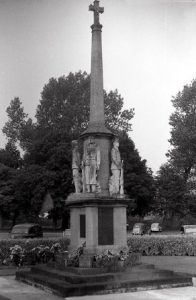
The Great War, 1914-1918
Edward John Allen, Private, 27741, South Wales Borderers. Edward was born at Kidderminster on 13 March 1893, the son of Edward Allen and Edith Annie Allen (nee Cale). The family had moved to 24, Oaklands, Builth Wells by 1903, and Edith died there that year. Edward worked as an apprentice bootmaker with his father prior to the war. He enlisted at Builth into the 2/1st Brecknockshire Battalion, South Wales Borderers soon after the outbreak of war. Edward was drafted out to India to join the 1/1st Brecknocks in the summer of 1916, before volunteering for active service in Mesopotamia. He was initially transferred to the Devonshire Regiment before being transferred again to the 4th Battalion, South Wales Borderers, which was attached to the 40th Brigade, 13th (Western) Division. The division had fought throughout the Gallipoli campaign, then on 8 January 1916, was evacuated from Helles, and by 31 January was concentrated at Port Said, where they held forward posts in the Suez Canal defences. On 12 February 1916 the Division began to move to Mesopotamia, to strengthen the force being assembled for the relief of the besieged garrison at Kut al Amara, but the relief failed, and Kut fell to the Turks. The Division then took part in the advance through Mesopotamia, which was to successfully liberate the country from 100’s of years of Ottoman rule. Edward was killed in action during this advance, on 30 April 1917. The 24-year-old has no known grave and is commemorated on the Basra Memorial, Iraq.
Gilbert Arthur, Private, 36650, Machine Gun Corps. Gilbert was born at St. Harmon on 1 November 1894, the son of John Llewellyn Arthur and Sarah Anne Arthur (nee Price). The family had moved to Pendre Villa, Park Road, Builth Wells by 1911 and Gilbert was working as an apprentice in his parents Grocery business. Gilbert enlisted into the army soon after the outbreak of war and after completing his training was drafted out to France in 1916 to join the 2nd Battalion, Manchester Regiment, which was attached to the 5th Division. The division saw plenty of action during the Somme offensive that year, taking part in the fighting at High Wood, Guillemont, Flers-Courcelette, Morval and Le Transloy. On 5 October, after suffering heavy casualties, the Division moved to Festubert, where it remained until March 1917 when it moved south to join the Battle of Arras, fighting at the Battle of Vimy in April 1917, and the attack on La Coulette. On 3 May the division fought in the Third Battle of the Scarpe, and captured Oppy Wood. On 7 September, the division was pulled out of the line again, and moved north to join the great offensive at Ypres, taking part in the Battle of Polygon Wood, then during the further fighting at Broodeseinde and Poelcapelle in September. From 26 November the division fought in the Second Battle of Passchendaele and was still situated here when news was received that the division was to be transferred to Italy, to bolster the Italians in the line along the river Piave, and finally took up positions there in late January 1918. Unfortunately, this pleasant period was not to last, for the Division was recalled hurriedly to France, following the German offensive of 21 March 1918. By the time the division reached France, Gilbert was serving with the 5th Battalion, Machine Gun Corps, which was attached to the 5th Division. The division moved to Flanders and took part in the Battle of Hazebrouck, where it played an important role in the Defence of Nieppe Forest. On 14 August, the 5th Division was withdrawn for rest and placed in GHQ Reserve, then two weeks later it joined the great Allied offensive, which was launched on 21 August, towards the Hindenburg Line, attacking from the Foncquevillers area towards Irles. The division then advanced past Beugny and had a brief rest before returning to the new front line at Ytres by 12 September. Gilbert was badly wounded whilst in the line here on 14 September 1918 and was evacuated to a nearby Casualty Clearing Station where he died of his wounds less than two hours later. The 24-year-old is buried in Grevillers British C4emetery, Bapaume, France. His younger brother, Penry George Arthur, was awarded the Distinguished Conduct Medal and the Belgian Croix-de-Guerre during the war.
Donald Frank Bailey, Sub-Lieutenant, Royal Naval Volunteer Reserve. Donald was born at Leatherhead, Surrey on 11 August 1893, the son of John Robert Bailey and Elizabeth Bailey (nee McIntosh). His father died in 1894, so the family moved to Elizabeth’s native home at Bromyard. Donald was educated at Uppingham School, in Rutland before becoming a Medical Student at St. Bartholomew’s Hospital in London in 1913. By now his mother had remarried to Reverend Sydney Herbert Wenham and was residing at The Vicarage, Builth Wells. Donald left St. Bart’s to enlist into the Public Schools Battalion, Royal Fusiliers soon after the outbreak of war and served in France with Lady Dudley’s Hospital from August 1914 to April 1915, when he enlisted into the Royal Naval Volunteer Reserve, initially with the rank of Able Seaman, and was posted to Blandford Camp. On 30 September 1915 he was commissioned as Sub-Lieutenant and was drafted to the Middle East on 5 December 1915 to join Hood Battalion, Royal Naval Division. The division had taken part in the Gallipoli campaign, and upon being evacuated to Egypt in January 1916 was transferred from the authority of the Admiralty to the War Office on 29 April 1916, before being redesignated the 63rd (Royal Naval) Division on 19 July 1916. The Division moved to France, arriving at Marseilles between 12 and 23 May 1916 and moved to positions on the Somme, where it took part in the Battle of the Ancre, and the resulting Operations on the Ancre, before wintering at Le Crotoy, at the mouth of the Somme. The division moved back into the line at the beginning of January 1917, taking over the Hamel sector, before being relieved at the end of March and moved to the Arras Sector, in readiness to take part in the forthcoming Battle of Arras. The division was in reserve when the battle opened on 9 April and soon received news that the Canadians had captured Vimy Ridge. By 14 April, Hood Battalion had moved into support positions, in the old German front-line in front of Gavrelle, then on 18 April moved into the front line to begin a short tour in the line, digging assembly trenches in readiness for the next stage of the offensive. Hood Battalion moved into position on the night of 22 April and at dawn on the following morning, 23 April 1917, attacked the village of Gavrelle together with Hawke Battalion. Donald was wounded during the attack that morning and was last seen leaving a dug-out which was being used as the Regimental Aid Post. No trace of the 23-year-old was ever seen again, and it is presumed that he was killed by a shell just afterwards. Donald has no known grave and is commemorated on the Arras Memorial, France. His half-brother, Captain David Herbert Wenham, was awarded the Military Cross for his gallantry in Burma during the Second World War.
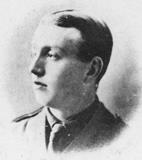
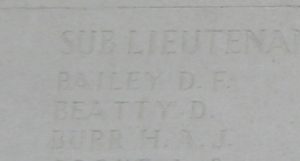
Reginald James Bevan, Private, 1881, Australian Infantry. Reginald was born on 9 September 1894, the son of James Bevan and Agnes Bevan (nee Wasley), of Henallt Cottage, Hay Road, Builth Wells. His father worked as a carpenter on Lord Glanusk’s estate. Reginald was educated at Builth Wells School and had served for two years with the Brecknockshire Battalion, South Wales Borderers before leaving left home at the age of 16 to emigrate to Australia aboard the SS Gothic, working his passage. He then found work as a Night Porter at the Bull and Mouth Hotel in Melbourne. On 5 July 1915 Reginald enlisted at Melbourne into the 3rd Reinforcement Draft for the 26th Battalion, Australian Infantry. The draft embarked at Brisbane aboard HMT Kyarra on 16 August and sailed for Egypt via the Suez Canal. Reginald then joined the 26th Battalion at Gallipoli on 12 October 1915. On 24 October 1915, just twelve days later, he was on duty at Rhododendron Spur, when he was shot in the head by a Turkish sniper and killed instantly. The 21-year-old was buried in Waldron’s Point Burial Ground that same day. The cemetery is now named as the 7th Field Ambulance Cemetery, at Gallipoli, after the Field Ambulance it was neighbouring.
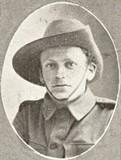
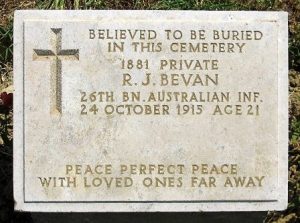
Charles Burton, Private, Royal Field Artillery. Charles cannot presently be identified.
Charles Davies, Corporal, E/820, Royal Fusiliers. Charles was born at Builth Wells on 15 September 1889, the son of John Davies and Elizabeth Davies (nee Hughes). His father died three months later, and by 1901 the family was residing at 3, Repler Road, Lambeth. Charles had begun his education at Llanelwedd School, before moving to Lambeth, where he continued his education at Hazelrigge Higher Grade School, Clapham. He then gained a scholarship to King’s College, London, before gaining a position as a clerk in the Accountant General’s Department of the General Post Office, London, and, subsequently, to the Board of Education. He enlisted at Clapham into the 17th Battalion, Royal Fusiliers soon after the outbreak of war. The battalion was raised in London by the British Empire Committee on 31 August 1914, moving to Worlingham, Surrey and then to Clipstone Camp, Notts to join 99 Brigade, 33rd Division. The division moved to Tidworth in August to complete its training, before landing at Boulogne on 17 November 1915 and entraining for Bethune before moving into the Festubert Sector for trench initiation and training. Once up top speed with life in the trenches, the infantry battalions of the division began the usual routines of rotating for duty, usually comprising of four days in support, four days in the front line then four days in reserve, mixed up with other duties which included carrying food and stores and digging trenches. At the end of February, the division moved slightly south and took over the Ettonnoir Sector. The 17th Royal Fusiliers moved into the front line here for the first time on 27 March to begin its first routine tour in this new sector. Charles was killed in action here on 3 March 1916 when the Germans fired a salvo of rifle grenades into the trenches. The 26-year-old is buried in Tranchee De Mecknes Cemetery, Aix-Noulette, France.
Edwin George Ernest Davies, Able Seaman, Z/1516, Royal Naval Volunteer Reserve. Edwin was born on 5 March 1886, the son of James and Evangeline Davies, of The Avenue, Merthyr Tydfil. Edwin commenced his education at Merthyr County School before being educated at Llandovery from 1901 to 1904. On leaving Llandovery, Edwin entered University College Cardiff to study Medicine. However, ill health forced him to abandon his medical studies, and he then entered St. David’s College, Lampeter, where he attained a B.A. degree in History. Later, in 1913, he entered Keble College, Oxford, where he was awarded a B.A. degree in Theology. He later became a curate at Southwark, London. While at Oxford, Edwin boxed at featherweight and was said to be one of the best at his weight at Keble College. He was later instrumental in establishing a flourishing Boxing Club in the East End of London. In 1914, Edwin was ordained curate at Builth Wells, and later that year he enlisted, joining the Royal Naval Division. He was posted to ‘D’ Company, Hawke Battalion, Royal Naval Division, which had been formed from the Public Schools Battalion, R.N.V.R. In the May of 1915, Edwin’s Battalion sailed for Gallipoli, arriving at Cape Helles on 27 May 1915, where they fought as Infantry on the Peninsula throughout the remainder of the year. Because of the evacuation at Anzac, the Turks were able to release the bulk of their artillery to shell the Allied troops at Helles. Edwin was one of between 60 and 70 of his Battalion to be killed and wounded during the ensuing Turkish bombardments on 27 December 1915. The 29-year-old has no known grave, is commemorated on the Helles Memorial, Gallipoli. One of his brothers, Mervin, died on active service in India in 1920.
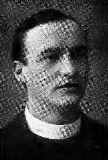
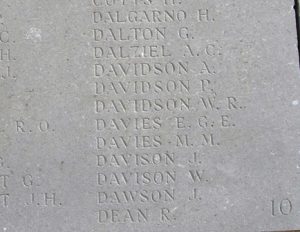
Jack Davies, Private, South Wales Borderers. Jack is shown on the memorial to have served with the Brecknockshire Battalion, South Wales Borderers. He cannot presently be identified.
John Rees Davies, Private, 269540, Royal Engineers. John was born on 29 December 1877, the son of Isaac and Sarah Davies, of Oakfield House, Llanafon. He married Mary Samuel in 1901 and the couple set up home at 33, Wye View Terrace, Builth Road, where their two sons were born. John worked for the London and North Western Railway, at their engineering department at Builth Road prior to the war. He enlisted into the Royal Engineers and was posted to the 343rd Road Construction Company, RE in France. By the summer of 1917 John’s Company was attached to XIX Corps, at Ypres. The Third Battle of Ypres opened on 31 July 1917 and the Company would have been employed in building and repairing roads in order to keep the flow of men and material flowing to the front lines. He was wounded within a couple of days of the launching of the offensive and died of his wounds at the 17th Casualty Clearing Station, Lijssenthoek on 8 August 1917, aged 39. John is buried in Lijssenthoek Military Cemetery, Belgium. John is not commemorated on the Builth Wells was memorial, but at Rhayader and at Cwmbach Llechryd.
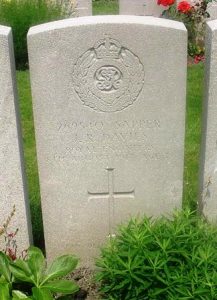
John Richard Davies, Private, 12834, Royal Dublin Fusiliers. John was born at Builth Wells in 1875, the son of Thomas Davies and Sarah Davies (nee Shurey). He married Alice Elizabeth Moore at Knighton in 1896 and by 1901 the couple were living at 45, Latimer Street, Sheffield, where John was working as a coal miner. John enlisted at Sheffield into the Royal Dublin Fusiliers soon after the outbreak of war. He was drafted to the Mediterranean in the early summer of 1915, landing at Gallipoli on 15 May 1915 to join the 1st Battalion, Royal Dublin Fusiliers. The battalion was rebuilding at Gallipoli following heavy losses during the opening weeks of the campaign and was attached to 86 Brigade, 29th Division. John was killed in action the following month, during the Battle of Gully Ravine, an action launched by the British following a French success on their flank. The 40-year-old has no known grave and is commemorated on the Helles Memorial, Gallipoli. John is not commemorated on the Builth Wells war memorial.
John Thomas Davies, Company Sergeant Major, T4/251132, Army Service Corps. John was born in 1876, the son of Abram Davies and Catherine Davies (nee Stanton), of Silverdale, Builth Wells. John trained as a butcher, before moving to Milford Haven just after the turn of the century. He married Charlotte Wilkes (nee Cole), a widower whose husband had been killed in a coal mine in 1898, at St. Catherine’s Church, Milford, on 4 April 1904. By 1911 the couple were residing at 94, William Street, Ystrad, Rhondda, where John was still working as a butcher, and by then the couple had three children, plus Catherine’s son from her first marriage. Following the outbreak of war, John enlisted at Llandaff into the Welsh Border Brigade, Army Service Corps. He was drafted to Mesopotamia in 1916 to join the Base Transport Depot, ASC. Conditions in the Mesopotamian theatre were terrible, with the hot, arid weather and proliferation of disease making life a misery for the men. Nobody knows what drove John to do it, but he committed suicide at Basra on 24 September 1917. The 41-year-old was buried in Basra War Cemetery, Iraq.
John Thomas Davies, Private, 28941, South Wales Borderers. John was born in 1898, the son of Thomas Davies and Sarah Davies, of Castle Row, Builth Wells. He worked as a butcher at Builth prior to enlisting into the South Wales Borderers at Brecon on 18 December 1916. John was then posted to the 3rd Battalion, South Wales Borderers, which was at Hightown, near Liverpool and upon completing his training was drafted to Mesopotamia on 12 February 1917, joining the 4th Battalion, South Wales Borderers, which was attached to 40 Brigade, 13th (Western) Division. John served overseas for about fourteen months before taking ill and was sent back to Britain in April 1918. He was sent to Bermondsey Military Hospital, Ladywood, where he was diagnosed as suffering from pulmonary tuberculosis. John was then transferred to the Breconshire Asylum at Hay, where he died of tuberculosis on 25 January 1919. The body of the 20-year-old was brought home to Builth, and he was buried there five days later. John is not commemorated as a casualty of war by the CWGC.
Reginald Stanley Davies, Private, 161272, Canadian Infantry. Reginald was born on 24 June 1885, the son of Thomas Davies and Mary Davies, of 8, Wye Terrace, Castle Street, Builth Wells. He had served for six years with the 1st Battalion, South Wales Borderers as a young man, then worked as a carpenter at Builth, before emigrating to Canada in about 1912. Reginald enlisted at Calgary, Alberta into the Canadian Expeditionary Force on 17 January 1915 and was posted to the 82nd Battalion, Canadian Infantry. The battalion embarked for Britain from Halifax on 20 May 1916 and after disembarking in Liverpool ten days later moved to Salisbury Plain, where it was used to provide reinforcements for units on the Western front. Reginald was then posted to the 102nd Battalion (Central Ontario), Canadian Infantry, which was attached to the 11th Brigade, 4th Canadian Division, and embarked with the battalion for France on 26 August 1916. The division arrived in time to bolster the Canadian Corps on the Somme, taking part in the Battle of Le Transloy from 1 to 17 October, and then during the Battle of the Ancre Heights from 17 October until 11 November, helping in the capture of the Regina Trench. The Canadian Corps saw its last major action that year during the Battle of the Ancre from 13 to 18 November, before the fighting calmed down for the winter. The Canadians then moved north of Arras, to positions facing Vimy Ridge, where they began to prepare for the forthcoming Battle of Arras. The Canadians had been tasked with the capture of Vimy Ridge, a formidable position which afforded grand views over both Allied and German lines. During the night of 8 April 1917, the men began advancing to their assembly positions for the assault. The weather was cold and soon turned to sleet and snow as zero hour came and the Canadians had to attack in abysmal conditions. Reginald was killed in action during the assault on Vimy Ridge that day, 9 April 1917. The 31-year-old is buried in Givenchy Road Canadian Cemetery, Neuville-St. Vaast, France.
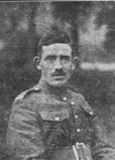
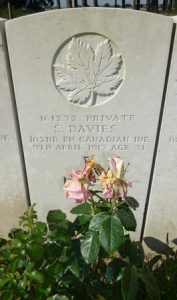
Thomas Davies, Private, G/40115, Middlesex Regiment. Thomas was born in 1889, the son of Charles Davies and Mary Davies (nee Jenkins), of Penbryn Farm, Cribyn, Cardiganshire. He was a Bank Clerk for the London and Provincial Bank at Llandrindod Wells and at Builth Wells prior to the war. Thomas enlisted into the Banker’s Battalion, Royal Fusiliers at Builth on 24 November 1915, and was posted to France on 31 August 1916, where he transferred to the 12th Battalion, Middlesex Regiment, which was attached to 54 Brigade, 18th (Eastern) Division. The Division was on the Somme, after having taken part in the Battle of Albert, when Thomas arrived. The division then fought at the Battle of Bazentin, where it captured Trônes Wood, before taking part in the Battle of Delville Wood. In October the division took part in the Battle of the Ancre Heights, capturing Schwaben Redoubt, and helped capture Regina Trench on 25 October. Thomas was wounded in the neck and chest in Regina Trench on 27 October 1916 and was evacuated via No 12 Canadian Field Ambulance to No 11 Casualty Clearing Station where he died later that same day. The 27-year-old is buried in Varennes Military Cemetery, France.
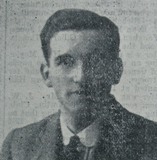
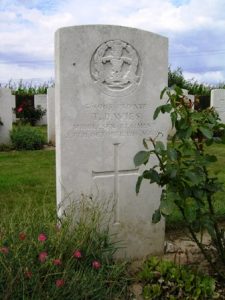
William James Davies, Private, 54827, Machine Gun Corps. William was born in 1876, the son of William Davies and Mary Ann Davies, of Llanddewi’r Cwm, Builth Wells. He married Christina Deans, the daughter of John and Margaret Deans, of Castle Cottages, Builth in 1913 and the couple had two children born over the next two years. William worked for Lord Glanusk prior to enlisting at Builth into the South Wales Borderers during the summer of 1915, then upon completing his training was posted to the 46th Company, Machine Gun Corps. The Company had formed at Grantham before embarking at Southampton on 8 February 1916 to join 46 Brigade, 15th (Scottish) Division, which was still in the Loos Sector. The 46th Company set up its guns in positions in the Mazingarbe area, where its gun sections began to follow the by now routine schemes of rotating for duty in the trenches. The division moved to the nearby Vermelles Sector in April, where it was involved in German gas attacks near Hulluch on 27 April, and in the defence of the Kink position. In July the division moved to the Somme, where it took part in the Battle of Pozieres, and then fought at Battle of Flers-Courcelette, where it captured Martinpuich. In October the division fought at the Battle of Le Transloy, and also in the Attacks on the Butte de Warlencourt, before wintering in positions northwest of Le Sars. In February 1917 the division was relieved and moved north to the Arras Sector, to prepare for the forthcoming Battle of Arras, which was planned to be launched on 9 April 1917. The division moved into position on the night of 8 April and on the following morning took part in the opening assaults of the battle, assaulting positions to the north and east of Monchy-le-Preux. After six days of heavy fighting, on 15 April the 46th Company MGC was relieved and moved back to billets at Duisans, before returning to the line on the night of 21 April, to take part in further offensive operations. The Company was tasked with firing a machine-gun barrage to support the advance by the Divisional infantry during their assault at dawn on the following morning, 22 April 1917. William was killed when the Germans opened up a heavy artillery barrage upon the Company machine-gun positions that day. The 41-year-old has no known grave and is commemorated on the Arras Memorial, France. His nephew, Christopher Deans, also fell.
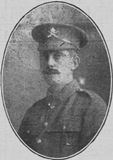
Christopher Deans, Private, 11419, South Wales Borderers. Christopher was born Christopher Williams at Builth in 1895, the son of Lucy Williams. His mother married John Deans on 23 December 1899, and Christopher was raised as his son at 1, Castle Row, Builth. Christopher enlisted into the 3rd Battalion, South Wales Borderers prior to the war, so was a Special Reservist. As soon as war was declared he was mobilised at Brecon and embarked for France on 29 November 1914, entraining for Flanders to join the 1st Battalion, South Wales Borderers, which was attached to 3 Brigade, 1st Division. The division had suffered terrible casualties during its vital actions during the defence of Ypres the previous weeks and had just moved to new positions near Outtersteene to rebuild. On 20 December the now rebuilt 1st SWB left for Merris, before the 1st Division took up new positions in the line at Festubert, a wet marshy area. On Christmas Day the men were in the trenches, cold and wet, when they were presented with their Princess Mary gift tins, which contained cards and gifts on behalf of the Royal Family. The line was relatively quiet over this period, but the trenches were flooded and in a terrible state. On 4 January 1915 the 1st SWB were relived and moved back to Bethune, where the men were allowed to bathe and received issues of clean clothes, before moving back into the Festubert trenches four days later. The battalion remained in the line here until 14 January when it relieved the Black Watch at Givenchy. At dawn on 25 January 1915 the Germans hit their lines with an intensive artillery bombardment, before launching an infantry assault, breaking through 100 yards of trench and reaching Givenchy village. Heavy fighting raged throughout the day as the Germans were driven back and the line regained. Christopher was killed in action during the fighting that day. The 19-year-old has no known grave and is commemorated on the Le Touret Memorial, Richebourg-L’avoue, France. His uncle, William James Davies, also fell.
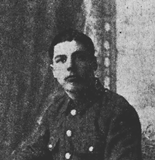
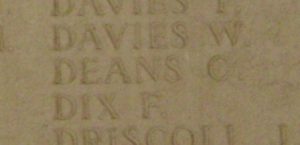
Benjamin William Evans, Private, Canadian Infantry. Benjamin was born at Builth in 1889 but cannot presently be otherwise identified.
Edward Ivor Evans, Lance Corporal, 10539, South Wales Borderers. Edward was born on 26 July 1894, the son of Henry James Evans and Margaret Evans (nee Jones), of Bank Square, Builth Wells. His father died in 1910 and by the following year Edward was lodging at Ynysybwl, where he was working as a coal hewer, whilst his family had moved to 12, Oaklands, Builth. Edward had enlisted into the 3rd Battalion, South Wales Borderers at some time prior to the war and was a Special Reservist. As soon as war was declared he was mobilised at Brecon and embarked for France on 20 September 1914, joining the 1st Battalion, South Wales Borderers, which was on the Marne, attached to 3 Brigade, 1st Division. The Division had taken part in the Battle of Mons on 23 August, following the German invasion of the low countries, and in the epic withdrawal from Mons to the River Marne, where the German drive on Paris was halted. The Germans then withdrew north and took up defensive positions north of the river Aisne, along the Chemin des Dames Ridge and the BEF advanced before launching a frontal attack upon the German positions. This battle marked the beginnings of the formation of the long line of trenches which became known as the Western front. The BEF then began moving to Flanders on 17 October, before advancing from Poperinghe past endless numbers of refugees and took up positions guarding the strategically vital city of Ypres, the 1st Division taking up positions near Langemarck by 21 October. Later that day the division was attacked by hordes of Germans, mainly young student-soldiers, who were mown down by the highly trained British soldiers. The Germans maintained their attacks over the coming days but were held at bay, sustaining terrible losses, and the line here stabilised, so by 27 October the 1st Division moved to positions near Zandvoorde, guarding the Menin Road. On 31 October 1914 the 1st Division faced its sternest test so far, when the Germans attacked its positions on the Menin Road, behind a fearsome artillery bombardment. The 1st Division was virtually annihilated during the ensuing fighting, with the survivors of 3 Brigade being over-run, but a counterattack by the Worcester’s regained the line. The survivors went into reserve at Hooge, before relieving the 4th Guards Brigade at Zillebeke on the night of 9 November. Edward was killed when the Germans opened up a terrible artillery barrage upon their trenches on 11 November 1914. The 20-year-old has no known grave and is commemorated on the Ypres (Menin Gate) Memorial, Belgium.
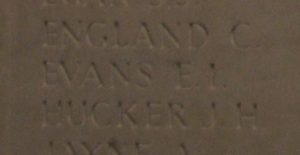
Lambert Tidman Evans, Stoker 1st Class, SS/109283, Royal Navy. Lambert was born on 12 July 1889, the son of William Humphrey Evans and Susannah Evans (nee Tidman), of 30, Oaklands, Builth Wells. He left Builth as a young man and enlisted into the Royal Navy on 29 September 1909. Lambert was posted to HMS Vivid II for training, before receiving his first posting aboard HMS Argyll on 8 February 1910. He remained aboard her until returning to Vivid II on 13 May 1911, then eleven days later was posted aboard HMS Donegal, serving aboard her for a year before returning to Vivid II. On 30 July 1914 Lambert was posted aboard the armoured cruiser HMS Monmouth. She was assigned to the reserve Third Fleet but following the outbreak of war was recommissioned and assigned to the 5th Cruiser Squadron in the Central Atlantic to search for German commerce raiders and protect Allied shipping. She was detached upon arrival to patrol the Brazilian coast for German ships and was later ordered to the South Atlantic to join Rear Admiral Christopher Cradock’s squadron in their search for the German East Asia Squadron, utilising bases in South America and the Falklands. Cradock’s force was greatly outnumbered and outgunned, but when it came into the Germans off the coast of Chile on 1 November 1914 Cradock ordered his ships to form a line behind HMS Good Hope and begin steaming towards the Germans to close the range. The German flagship, Scharnhorst, engaged Good Hope while Gneisenau fired at Monmouth. Both ships guns were still out of range, so they could not return fire and soon Monmouth received a direct hit which blew up her forward turret, starting a huge fire. The crippled Monmouth veered out of the line and was listing badly when the Germans went in for the kill. Monmouth steered towards the Germans to attempt to counterattack, but capsized and sank, with the loss of her entire crew of 734 men. Lambert was 25 years old when he was lost in the sinking of Monmouth that day. He has no grave and is commemorated on the Plymouth Naval Memorial, Devon.
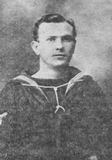
Raymond Llanwarne Buallt Evans, Private, 432368, Canadian Infantry. Raymond was born on 4 November 1894, the son of Evan Evans and Margaret Evans (nee Llanwarne), of Radnor House, Builth Wells. Following the early death of his mother, then his father, Raymond emigrated to Canada with his sister Hilda Violet, where he found work on the railways, setting up home at Nanton, Alberta. Violet was a renowned singer, who married a Canadian, Edward Meaden, in 1915. Raymond enlisted into the Canadian Expeditionary Force at Edmonton on 6 January 1915 and was posted to the 49th Battalion (Edmonton Regiment), Canadian Infantry. The battalion embarked for Britain on 3 June 1915, then completed its training at Salisbury Plain before embarking for France on 9 October 1915, as part of the 7th Infantry Brigade, 3rd Canadian Division. The division joined the other Canadian divisions in the Ypres Salient, taking up positions in front of Zillebeke. The men were then put to work on digging new trenches and defensive positions, whilst the infantry battalions of the division rotated for duty in the front line. Much of the work was carried out in the Locre area over the coming months, then by 21 March 1916 the 49th Battalion moved into Ypres itself, before taking over the line at Maple Copse and Railway Dugouts. Apart from the odd trench raid, from both German and Canadian parties, during this period, nothing of great note occurred until dawn on 2 June 1916, when the Germans attacked Mount Sorrel, Tor Top (Hill 62) and Hill 61, following a massive artillery bombardment. Four huge underground mines were also exploded by the Germans, before their infantry attacked, and Mount Sorrel and Hill 61 were lost. The road to Ypres lay wide open, but the Germans failed to capitalise on their breakthrough, and the Canadians then began a series of desperate counterattacks. Raymond was posted as missing believed killed during this terrible period, at sometime between 2 and 5 June 1916. The 21-year-old has no known grave and is commemorated on the Ypres (Menin Gate) Memorial, Belgium.
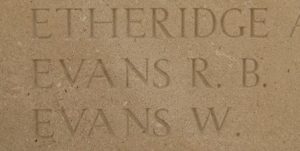
Benjamin Rees Gould, Private, 46407, Cheshire Regiment. Benjamin was the son of Benjamin and Mary Gould, of Tynllan, Disserth. He married Gertrude Mary Griffiths, of Newbridge-on-Wye, in 1912, and the couple lived at 1, Church Street, Builth Wells, where he worked as a gardener. Benjamin enlisted at Brecon into the Cheshire Regiment on 27 June 1916. He embarked at Southampton on 15 December 1916 and landed at Le Havre the following day, before joining the 22nd Battalion, Cheshire Regiment, a labour battalion. The battalion became the 65th Company, Labour Corps in April 1917, moving to Ypres. Benjamin was killed at Ypres on 19 June 1917, aged 28, while the Battle of Messines Ridge was raging. He was 28 years old and is buried in Poperinghe New Military Cemetery, Belgium.
William Seth Griffiths, Lance Corporal, 57092, Manchester Regiment. William was born in the Elan Valley on 9 November 1898, the son of Thomas Charles Griffiths and Elizabeth Anne Griffiths (nee Meredith). His father died in 1904, and Elizabeth moved to 1, Pendre Villa, Park Road, Builth Wells with her young family. William enlisted at Ludlow into the army and upon being drafted to France early in 1918 was posted to the 12th Battalion, Manchester Regiment. The battalion was attached to 52 Brigade, 17th (Northern) Division and was in position on the Hindenburg Support line when William arrived. The division was hit hard here following the launching of the German Spring Offensive on 21 March 1918, following an assault against the section of Western front running south from Croisilles to La Fère, and was forced to withdraw under intense pressure over the coming days, losing control of Havrincourt before withdrawing via Flers and Pozieres to Albert. After a period out of the line to rest and rebuild, the Division moved to the southernmost sector of the Somme area, where it fought at the Battle of Amiens on 8 August 1918, a day which saw the war swing in the favour of the Allies. The Allies then advanced on the Somme from 21 August, and the Division fought at the Battle of Albert later that month, then during the Battle of Bapaume on 31 August, as it advanced towards the Hindenburg Line. It saw heavy fighting at the Battle of Havrincourt on 12 September and at the Battle of Épehy on 18 September. At the beginning of October, the mighty Hindenburg Line was broken, and the 17th Division swept towards Cambrai, fighting at the Battle of Cambrai on 8 October, and then north-east through northern France, towards the old Battlefields of Mons and Le Cateau, during the Pursuit to the Selle. On 12 October 1918 the 12th Manchester’s lined up on the west bank of the Selle near Neuvilly before pressing an attack against the German defences. William was killed in action during the fighting that day. The 19-year-old has no known grave and is commemorated on the Vis-en-Artois Memorial, Haucourt, France.
Frederick Arthur Bowen Hamer, Private, 2283, Royal Fusiliers. Frederick was the son of William Bowen Hamer and Eda Blanche Hamer, of Hazelmere, Rhayader. He worked as a bank clerk for the London City and Midland Bank and lodged with Mr and Mrs Percy Davies, Glantroyddin, Builth Wells prior to the war. Frederick enlisted into the 26th Battalion, Royal Fusiliers soon after the outbreak of war. The battalion was known as the Bankers Battalion and had been raised by the Lord Mayor and City of London from 17 July 1915, from Bank Clerks and Accountants. The battalion moved to Aldershot joining 124 Brigade, 41st Division and on 4 May 1916 embarked for France. The Division moved to the areas of Ploegsteert and the Douve valley, south of Ypres for trench initiation, and remained here until August 1916, when it was moved to the Somme, taking part in the Battle of Flers-Courcelette. The Division remained in the line, pushing on to Courcelette over the next few days before coming out for a rest and re-fit. The Division then fought at the Battle of Le Transloy, before moving to positions south of Ypres, at St. Eloi, in 1917. Here the Division took part in the Battle of Messines Ridge in June 1917, before moving to the Meteren area for training and rebuilding. It then moved back into the line in the Ridge Wood sector at the end of July, in preparation to take part in the opening offensive of the Third Battle of Ypres, which was launched on 31 July 1917. The Division took part in heavy fighting over the coming weeks, as the Battle of Passchendaele raged. On 19 September 1917 the 26th Royal Fusiliers moved into positions at Voormezeele, in readiness to carry on the offensive, and at dawn the following day, 20 September 1917, launched an assault on the Tower Hamlets Ridge, suffering over 300 casualties during the days fighting. Frederick was killed at some time during the fighting that day. The 24-year-old has no known grave and is commemorated on the Tyne Cot Memorial, Belgium.
James Robert Harris, Private, 25772, South Wales Borderers. James was born in Yorkshire in 1888, the son of James Harris and Mary Jane Harris. The family came to live at Knighton soon after James was born, then by 1901 James had left home and was working as a carter at Boresford Farm, Brampton Bryan. He then came to Builth Wells to work as a timber feller and on 14 February 1910 married Martha Price at Builth. The couple set up home at Malt House Row, Builth Wells, where their four children were born over the coming years. James enlisted at Brecon into the South Wales Borderers early in 1915. He was drafted to the Mediterranean on 6 December 1915, joining the 4th Battalion, South Wales Borderers, which was at Gallipoli attached to the 40th Brigade, 13th (Western) Division. The division was evacuated from Suvla on 19 December 1915, transferring to Helles. On 8 January 1916, the Division was evacuated from Helles, and by 31 January was concentrated at Port Said, where they held forward posts in the Suez Canal defences. On 12 February 1916 the Division began to move to Mesopotamia, to strengthen the force being assembled for the relief of the besieged garrison at Kut al Amara, but the relief failed, and Kut fell to the Turks. The Division then took part in the advance through Mesopotamia, which was to successfully liberate the country from hundreds of years of Ottoman rule. James was killed in action during the advance through the desert on 11 April 1917. The 29-year-old has no known grave and is commemorated on the Basra Memorial, Iraq.
Rupert Charles Inglis, Lieutenant, South Wales Borderers. Rupert was born in Ceylon on 3 February 1884, the son of Charles George Inglis and Edith Caroline Inglis (nee Buckworth), of Glanwye, Builth Wells. His grandfather, Major Sir John Inglis, had been the commander of Lucknow during the famous siege in 1857, while Lord Chelmsford, of Zulu War fame, was his great-uncle. Rupert was educated at St. Andrew’s School, Eastbourne and at Uppingham before leaving for a new life in Canada. He returned to Britain after the outbreak of war and was commissioned into the South Wales Borderers in December 1914, along with his brother, Harold John Inglis. The brothers were posted to the 2nd Battalion, South Wales Borderers, which had just returned to England from service in China. The battalion joined 87 Brigade, 29th Division and in April 1915 embarked for the Mediterranean, before taking part in the Gallipoli Landings on 25 April 1915. Rupert was slightly wounded on 11 June in an engagement which saw him and his brother both recommended for the Military Cross. Rupert soon returned to duty and was wounded again whilst leading his men on an attack against the Turks on 28 June and died the following day, 29 June 1915, aged 31. He has no known grave and is commemorated on the Helles Memorial, Gallipoli. His death prevented his award of the Military Cross, as it was not a posthumous award. He is also commemorated at Builth Wells Parish Church. His brother Harold John Inglis, also served with the 2nd SWB and was awarded the Military Cross for the action, later being recommended for the VC, but being instead awarded the DSO: ‘Second-Lieutenant Harold John Inglis, 3rd Battalion, the South Wales Borderers (attached 2nd Battalion). For conspicuous gallantry on the 10th and 11th June 1915, during operations south-west of Krithia. He and his brother (Lieut. R. C. Inglis, of the same battalion) made a gallant attempt to capture an enemy’s sap, distant about 90 yards. Crawling over the open ground with their men, they reached the sap, which was about five feet deep, increasing to seven or eight feet, down which the party had to proceed in single file. The party were checked in the deepest part of the sap by machine gun fire and bombs and had to retire. Second-Lieutenant H. J. Inglis then made a second attempt and again seized the saphead. Advancing along the sap, he was wounded and was eventually forced to retire by very heavy rifle fire. He showed great skill and gallantry in a difficult position. Lieut. R. C. Inglis was wounded and has since died of his wounds.’
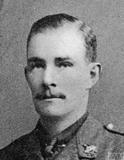
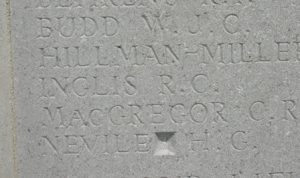
Frederick Victor Gilbert Jamison, Private, 21285, Canadian Infantry. Frederick was born at Belfast on 20 June 1887, the son of William and Orcilla Jamison. His father died in 1892, and his mother moved with Frederick to live with her uncle at Builth Wells. Frederick lived at Hazlehurst, Llandrindod Wells and had played football for Llandrindod FC prior to emigrating to Canada in 1913 and found work as a teamster at Winnipeg. Frederick enlisted into the 11th Battalion, Canadian Infantry at Valcartier on 24 September 1914 and embarked for England with the battalion. Upon arrival, the Canadians moved to Shorncliffe Camp. On 2 May 1915 Frederick was transferred to the 4th Battalion, Canadian Infantry, which was on the Western Front attached to the 1st Canadian Brigade, 1st Canadian Division. He joined the battalion at Bailleul, just before the battalion moved into reserve trenches at Festubert. Frederick saw his first major action soon after, at the Battle of Festubert, from 15-25 May. The Canadians then took part in the Second Action of Givenchy from 15 to 16 June, before moving to Ploegsteert. Over the coming months the Canadians carried out the usual routine of trench rotation, with the infantry battalions spending four days in the front line, four in support, then four in reserve, interspersed with providing working parties, and carrying out trench raids. In June 1916 the Canadians fought a desperate defensive action during the Battle of Mount Sorrel, following a German assault on Hill 62 and Mount Sorrel. The Canadians then moved to the Somme sector in September 1916, relieving the Australians at Pozieres, to continue the assault on Mouquet Farm. On 17 September Frederick’s battalion moved into the front line in front of Courcelette. Frederick was a Lewis Gunner in the battalion, and on 19 September 1916, while the battalion was preparing to launch an attack, the Germans hit them, entering the Canadian front line. Frederick’s Lewis Gun jammed, but he valiantly fired at the advancing Germans with his pistol until being shot dead, along with his gun crew. The 29-year-old has no known grave and is commemorated on the Vimy Memorial, France.
Hugh Thomas Jervis, Private, 26516, Welsh Regiment. Hugh was born in 1898, the son of Hugh Jervis and Elizabeth Jane Jervis (nee Daniels), of 17, Hospital Road, Builth Wells. The family moved to Merthyr just prior to the war and Hugh enlisted at Cefn Coed into the Welsh Regiment. He embarked for France on 12 May 1915, joining the 2nd Battalion, Welsh Regiment, which was in the Festubert sector, attached to 3 Brigade, 1st Division. Hugh became the officer’s orderly to Lieutenant Colonel Prothero, the commanding officer of the 2nd Welsh soon after joining the battalion. The battalion was fresh out of the trenches following heavy losses at Aubers Ridge just days before. After the battle of Aubers, the 2nd Welsh took over a section of old French trenches, where it received drafts of reinforcements. On 20 May, the Battalion was moved to the Cuinchy area, where it endured a great deal of bombing and rifle grenading, then at the latter end of June the Battalion moved to the Vermelles area, in preparation for the battle of Loos. The Battle of Loos was launched on 25 September 1915, following the release of large quantities of poison gas by the British. 3 Brigade moved off with the 2nd Munster’s on the right, the 2nd Welsh in echelon, to their left, and the 1st SWB in support. The gas had blown back over the British lines, so conditions during the advance were horrendous, then whilst advancing past the Vermelles-Hulluch Road the Brigade came under heavy machine-gun fire. Colonel Prothero, undaunted, drove the 2nd Welsh forward towards the German third line, Gun Trench, some 1,000 yards behind their first line, towards Hulluch, but the battalion soon found it was cut-off and surrounded. Hugh was killed in action at some time after this, whilst Colonel Prothero was captured by the Germans. The 17-year-old has no known grave and is commemorated on the Loos Memorial, France.
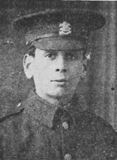
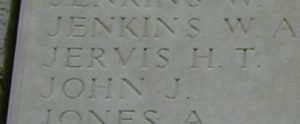
Evan Lloyd Jones, Private, 91695, Durham Light Infantry. Evan was born on 4 February 1899, the son of John Lloyd Jones and Jane Jones (nee Evans), of Ossian House, Eben’s Lane, Cardigan. He came to Builth Wells just after the outbreak of war to work as a bank clerk and lodged at Maes-y-Craig. Evan enlisted at Brecon into the 2/1st Battalion, Pembroke Yeomanry on 21 January 1917, and on 13 April 1918 was drafted to France, where he was transferred to the 1/6th Battalion, Durham Light Infantry, which was attached to 151 Brigade, 50th (Northumbrian) Division. The division had suffered terrible losses during the first stage of the German Spring Offensive from 21 March 1918 and had moved to positions near Éstaires to rebuild. Unfortunately, the Germans launched the second phase of their offensive in this area, along the Lys Valley, on 9 April, and the division was caught up in desperate fighting once more. After severe losses, the battered division was withdrawn and sent to IX Corps, on the Aisne, believed to be a much quieter area. This was unfortunately not the case, as the Division was hit hard by a surprise enemy attack, the third and final stage of the German Spring Offensive, on 27 May. The 6th DLI was in the line when the German attack struck, and by the end of the morning the battalion had been decimated. Evan was captured by the Germans at some time between 27 May to 31 May 1918 and was taken to a Prisoner of War Camp at Worms in Germany. He contracted dysentery whilst imprisoned at Worms and died at the camp hospital on 4 October 1918, aged 19. Evan is buried in Worms (Hochheim Hill) Cemetery, Germany.
Harold Vivian Jones, Lieutenant, Royal Welsh Fusiliers. Harold was born on 6 June 1893, the son of Robert William Jones and Agnes Annie Jones (nee Prosser), of The Pines, Builth Wells. He was educated at Builth Wells County School, before gaining a place at the University College of North Wales in Bangor in 1911. As a student he was Captain of the University Football Team and was one of the first members of the Builth Church Lad’s Brigade. At the outbreak of the war, Harold and his brother James Gordon Jones enlisted into the Royal Welsh Fusiliers and immediately both men gained commissions as Second Lieutenant into the 13th Battalion, Royal Welsh Fusiliers. The battalion had been raised at Rhyl on 3 September 1914 by the Denbigh & Flint T.F. Associations and transferred to the Welsh National Executive Committee on 10 October 1914, moving to Llandudno to join 128 Brigade, 43rd (Welsh) Division and began training at Rhyl and Colwyn Bay. On 29 April 1915 the formation became renumbered to 113 Brigade, 38th (Welsh) Division, before moving to Winchester in the summer of 1915 to complete its training. The Division moved to France on 2 December 1915 and moved to the Nursery Sector near Fleurbaix for trench initiation alongside the Guards Division. The Division then held a sector of the line near Cuinchy before marching south to the Somme sector in June 1916 to take part in the assault on Mametz Wood. The first attack on the wood was launched on a two-battalion front on 7 July, but failed, and the Divisional Commander, Sir Ivor Philipps, was replaced before the Division attacked again on a two Brigade front on 10 July 1916. The 13th RWF attacked with 113 Brigade from north of White Trench. Harold was killed almost immediately as the battalion made its assault. The 23-year-old was originally buried in Mametz Wood, but his grave was located by men of the 113th Labour Company in July 1919, during the battlefield clearances, and he was re-interred in Flatiron Copse Cemetery, Mametz, France.
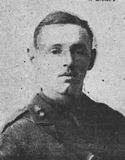
Herbert Thomas Jones, Private, 16745, Sherwood Foresters (Notts & Derby Regiment). Herbert was born in 1887, the son of Thomas Jones and Margaret Anne Jones (nee Powell), of Brookland House, Builth Wells. He worked as a motor mechanic prior to enlisting into the army at Tonypandy soon after the outbreak of war and was posted to the 12th Battalion, Sherwood Foresters. The battalion formed at Derby on 1 October 1914, before joining the 24th Division in the Shoreham area. In April 1915 the battalion became the Divisional Pioneer Battalion to the 24th Division and landed in France on 29 August 1915, moving to the Loos sector for trench initiation and training. The inexperienced division was thrown into action at the Battle of Loos on 26 September 1915 and suffered terrible losses before being withdrawn. Just weeks later, Herbert fell ill and was hospitalised, returning to England to recuperate. Upon returning to France, he was transferred to the 16th Battalion, Sherwood Foresters, which was attached to 117 Brigade, 39th Division. The Division had moved to France at the end of February and early March 1916, and on 30 June 1916 it took part in a very costly attack against the Boar’s Head Sector, near Richebourg l’Avoue, with its Sussex Battalions in particular suffering very heavy casualties. The 16th Sherwood Foresters remained in the Ferme du Bois area during the weeks after this costly affair, carrying out the usual routines of trench warfare and also carried out a trench raid on 12 July. Herbert is recorded as having been killed in action whilst in this sector on 30 July 1916. The battalion was, however, in reserve at the time, and there is no mention of any fatalities on that day. The 29-year-old has no known grave and is commemorated on the Loos Memorial, France.
John Jones, Private, 27773, South Wales Borderers. John was from Conway, Caernarvonshire. He came to Builth Wells prior to the war and lived with his wife, Ann Elizabeth Jones, at Llanelwedd Villa, Builth Wells. John enlisted into the 1/1st Brecknockshire Battalion, South Wales Borderers soon after the outbreak of war. The battalion was attached to the Welsh Division and moved to Pembroke Dock upon mobilisation. It was then withdrawn from the Division and on 29 October 1914 sailed from Southampton for Bombay, where the battalion transhipped and sailed for Aden, arriving on 16 December 1914. The battalion endured a torrid time in the heat of Aden, losing several men to heatstroke. In August 1915 the battalion moved to India on garrison duties. John, like many other men in the battalion, found garrison duties tedious, so volunteered to transfer to the 1/6th Battalion, Devonshire Regiment, which was in Mesopotamia. Upon their arrival, the men were transferred again, joining the 4th Battalion, South Wales Borderers, which was attached to 40 Brigade, 13th (Western) Division. The division had moved to Mesopotamia from Egypt, following service at Gallipoli, to strengthen the force being assembled for the relief of the besieged garrison at Kut al Amara, but the relief failed, and Kut fell to the Turks. The Division then took part in the advance through Mesopotamia, which was to successfully liberate the country from hundreds of years of Ottoman rule. John was killed in action on 15 February 1917, soon after the move. He has no known grave and is commemorated on the Basra Memorial, Iraq. His widow, Anne Elizabeth, married James Nolan in 1918 before moving to Belgrave, Spa Road, Llandrindod Wells.
John Lewis Jones, Second Lieutenant, Welsh Regiment. John was born in 1883, the son of Doctor William Lewis Jones and Elizabeth Jones, of Glyncothy House, Nantgaredig. He was orphaned at an early age, and brought up by family at Maesionydd, Caio and then with his cousins, Mrs. Walters and Miss Davies, at Walters Hotel, Lampeter. John had studied at Pembroke College, Oxford, and St Michael’s College, Llandaff, intending to become a member of the cloth, however, with the outbreak of war he enlisted into the Public Schools Battalion, Royal Fusiliers. He was then commissioned as Second Lieutenant into the 3rd Battalion, Welsh Regiment, and embarked for France to join one of the front-line battalions of the regiment. John served on the Western Front for over a year before being gassed and was invalided back to Britain. He spent a time at Kinmel Park Hospital and then at Eaton Hall before coming to live with his aunt at Dolgarreg, Builth Wells, where he lived for several months. Unfortunately, his health continued to wane, and John was taken to Bedford House Hospital, in Cardiff, where died on 13 August 1917. The remains of the 32-year-old were taken to Llanegwad, and he was buried near his parents in St. Egwad’s Churchyard, Llanegwad.
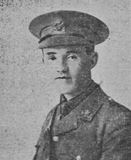
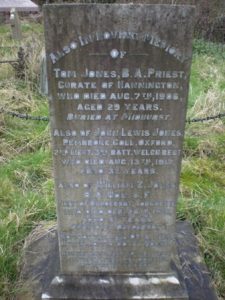
Luther Pryce Jones, Lance Corporal, 588, Australian Infantry. Luther was born on 21 November 1890, the son of Thomas Jones and Catherine Jones (nee Hobby), of Pwllgwyn Farm, Llanddewi’r Cwm, Builth Wells. Luther decided to start a new life in Australia as a young man, so on 25 November 1910 left England aboard the SS Osterley bound for Fremantle. He then gained work as a shearer. Luther enlisted into the 44th Battalion, Australian Infantry at Perth on 8 January 1916. The battalion was raised at Claremont, Western Australia, in February 1916 as part of the 11th Brigade, 3rd (Australian) Division and embarked at Fremantle aboard HMT Suevic on 6 June 1916 bound for Britain. The 3rd Division completed its training on Salisbury Plain before moving to France in November 1916, to join the other four infantry divisions of the AIF. On the following month, the battalion entered the front line for the first time and its infantry battalions began the regular routine of rotating between the trenches. The 44th Battalion’s first major test was during a large-scale trench raid on 13 March 1917, which proved unsuccessful. The battalion then saw its first major action during the Battle of Messines Ridge on 7 June 1917, when the Allies exploded a series of vast underground mines beneath the German positions, before launching an infantry assault, supported by tanks, and captured the ridge. The Australians then enjoyed a brief rest period before moving to Ypres to take part in the bloody fighting for Broodseinde Ridge, which was captured on 6 October. Luther was killed in action during a subsequent action at Frezenberg on 10 October 1917. The 26-year-old has no known grave and is commemorated on the Ypres (Menin Gate) Memorial, Belgium.
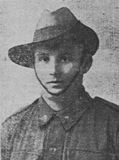
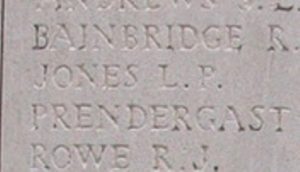
Thomas John Jones, Lance Corporal, 307514, Lancashire Fusiliers. Thomas was born in 1887, the son of Thomas Meredith Jones and Elizabeth Jones, of Cefnpeveredd, Maesmynis, Builth Wells. Both his parents died in the autumn of 1892, so Thomas and his siblings went to live with Edward Johnson Lewis and Elizabeth Lewis at Penarth, assuming their surname. Thomas worked as a grocer’s assistant for Stranaghan and Stephens Grocery Stores prior to the war. He married Emily Agnes Ada Jenkins in 1913 and the couple set up home at 7, Sully Terrace, Penarth. Thomas enlisted under the name of Thomas John Lewis into the South Wales Borderers soon after the outbreak of war. Upon being drafted to France he was transferred to the 2/8th Battalion, Lancashire Fusiliers, which was attached to 74 Brigade, 25th Division. The division had been in France since 26 September 1915 and had seen its first major action when it defended Vimy Ridge against a German attack in May 1916. The division then moved to the Warloy area and attacked on 3 July near Thiepval and remained on the Somme throughout the remainder of the offensive before moving north to the Ploegsteert Sector. It held the line here over the coming months leading up the Battle of Messines in June 1917, then saw further fighting during the Battle of Pilckem, remaining in the Ypres Salient over the winter. In February 1918 the division moved south, taking over positions near Villers-Bretonneux, facing Lamotte, in the Somme Valley. On 21 March 1918 the Germans launched the first stage of their great offensive along the section of Western front running south from Croisilles to La Fère, and the 25th Division became caught up in the desperate fighting which ensued as it fought to prevent the Germans advancing towards Amiens. Thomas was posted as missing during the opening day of the offensive, on 21 March 1918, and was later adjudged to have been killed on that date. The 31-year-old has no known grave and is commemorated on the Pozieres Memorial, France. (Thomas is most likely the man listed on the Builth Wells war memorials at J. T. Jones).
Charles Ellis Martin, Gunner, 57582, Royal Garrison Artillery. Charles was born in 1893, the son of Job Martin and Sarah Martin (nee Jones), of 30, Oakland Cottage, Llanddewi’r Cwm, Builth Wells. He had served with the Brecknockshire Battalion, South Wales Borderers (Territorials) from 1908 until 1912 and had served as a Policeman at Brynmawr prior to the war. He enlisted there into the Royal Garrison Artillery alongside his friend and colleague PC Thomas Henry Pitman. Charles was posted to France early in 1916, joining ‘Y’ 34th Trench Mortar Battery, Royal Garrison Artillery. He served during the Somme offensive that summer, and towards the end of 1916 returned home to Brynmawr on two weeks leave. Charles had only been back in France a week when he was mortally wounded and died on 16 January 1917 aged 23. He is buried in Hazebrouck Communal Cemetery, France. Charles is also commemorated on the recently unveiled Dyfed Powys Police Memorial at Llangunnor.
William Ernest Mason, Private, 95802, Royal Defence Corps. William was born on 25 May 1887, the son of John Mason and Jane Mason (nee Evans), of Llanelwedd Villa, Builth Wells. He worked as a postman for many years prior to enlisting into the army and was posted to Bush Camp, in Pembrokeshire. William married Lilian May Pearce at Aberedw on 27 February 1916, before returning to Bush Camp, where he was baptised the following month. He was posted to France on 26 February 1917 to join the 1st (Garrison) Battalion, King’s Liverpool Regiment, then on 13 May was transferred to the 66th Company, Labour Corps. William was then transferred to the 14th Battalion, Hampshire Regiment on 3 October 1917, but must have been suffering from poor health as he was transferred home to the Royal Defence Corps on 15 December 1917. He was discharged from the army after the war and returned home to his wife Lilian at The School House, Aberedw, but his health continued to fail, and William died of osteitis on 8 May 1920. The 31-year-old was buried in St. Cewydd Churchyard, Aberedw four days later. William is not commemorated on the Builth Wells war memorials.
Evan Morgan, Private, Bedfordshire Regiment. Evan cannot presently be identified.
Edward Thomas Morgan, Private, 12856, South Wales Borderers. Edward was born at Builth Wells in about 1890. By 1911 he was residing at Rhymney and later that year married Agnes Harding, of 88, Plantation Street, Rhymney. Edward enlisted at Newport into the 4th Battalion, South Wales Borderers soon after the outbreak of war. The battalion formed at Brecon, before moving to Park House Camp, near Tidworth to join 40 Brigade, 13th (Western) Division, then moved to billets in Cirencester before moving to Woking in March 1915 for final training. On 29 June 1915 the Division sailed from Avonmouth for Mudros, before landing at Cape Helles, Gallipoli on 15 July 1915. Two weeks later the Division was moved to Anzac, to reinforce the Australian and New Zealand troops there, in readiness for a great assault on the Sari Bair Ridge, in conjunction with fresh Allied landings at Suvla Bay. The assault began on 6 August 1915 and raged over the coming days. The 4th SWB reached the Achyl Dere before assaulting, and seizing Damakjelik Bair, one of the ridges held by the Turks. The Turks counter-attacked on 9 August and terrible fighting raged throughout the day. Edward was killed in action here on 12 August 1915. He is buried in the 7th Field Ambulance Cemetery, Gallipoli. Edward is not commemorated on the Builth Wells war memorials.
Idris Aneurin Morgan, Captain, South Wales Borderers. Idris was born in 1889, the son of Alfred Phillips Morgan and Alma Morgan (nee Protheroe), of Glyn-Gwy, Builth Wells. He was educated at the University of Wales at Aberystwyth, where he became well known as a lay preacher. Idris then gained a teaching position at High Wycombe Royal Grammar School in 1912. He left his position there to enlist into the army and on 17 January 1915 was commissioned as Second Lieutenant into the 10th Battalion, South Wales Borderers. He was then transferred to the sister battalion, the 11th Battalion, South Wales Borderers. The battalion was at Colwyn Bay attached to the 43rd (Welsh) Division. The Division trained in North Wales before moving to Winchester in the summer of 1915, where the formation became renumbered 115 Brigade, 38th (Welsh) Division. The Division began moving to France on 2 December 1915 and moved to the Nursery Sector near Fleurbaix for trench initiation alongside the Guards Division. The Division then held a sector of the line near Cuinchy before marching south to the Somme sector in June 1916 to take part in the assault on Mametz Wood. The first attack on the wood was launched on a two-battalion front on 7 July, but failed, and the Divisional Commander, Sir Ivor Philipps, was replaced before the Division attacked again on a two Brigade front on 10 July 1916. After two days of ferocious hand-to-hand fighting, the wood was cleared up to its northern edge, before the battered Division was relieved. It then took over a section of the front at Hébuterne before moving to the Ypres Salient and taking over the Canal Bank sector at Boesinghe. The infantry battalions of the Division then began carrying out the normal pattern of rotation in the trenches, four days in the front, four in support and four in reserve, whilst also working on trench improvement, digging new trenches, and carrying out regular patrols and trench raids. On 31 July 1917 the Division launched its famous assault on the Pilckem Ridge, capturing Iron Cross and reaching its objective of the Steenbeek, then played a supporting role in the Battle of Langemarck. The Division was transferred to the Sailly-sur-la-Lys sector in September, and remained in the area over the winter, then in February 1918 the 11th Battalion, South Wales Borderers was disbanded, and Idris was posted to the 2nd Battalion, South Wales Borderers, which was attached to 87 Brigade, 29th Division. The Germans launched their Spring Offensive on the Somme on 21 March 1918, and weeks later launched a fresh assault on the Lys. The 29th Division was caught up in this, and over the coming days fought a desperate rear-guard action. Idris was killed near St. Silvestre on 17 April 1918, during a day of terrible fighting. The 28-year-old was originally buried on the battlefield, but his grave was located during the post war battlefield clearances, and he was re-interred in Meteren Military Cemetery, France.
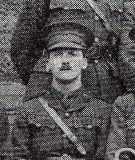
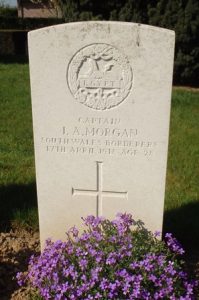
John Morgan, Private, Royal Welsh Fusiliers. John cannot presently be identified but lived at Smithfield Road prior to the war.
John Probert Morgan, Private, G/22792, The Queen’s (Royal West Surrey Regiment). John was born in 1877, the son of John Morgan and Catherine Morgan, of Lynden House, Builth Wells. He was living in Hendon, Middlesex when war broke out and enlisted there into the Middlesex Regiment. Upon being drafted to France at some time in 1916, John was posted to the 6th Battalion, The Queen’s (Royal West Surrey Regiment), which was attached to 37 Brigade, 12th (Eastern) Division. The Division had landed at Boulogne on 31 May 1915, taking over the line at Ploegsteert Wood. It then moved south and fought in the Battle of Loos, and the subsequent actions of the Hohenzollern Redoubt, and remained in the Loos area until March 1916. By June the division was in position at the Somme and attacked Ovillers on 2 July. It then took part in the desperate fighting at Pozieres and Le Transloy before being moved to the Arras area during October 1916. The division wintered here and began preparing for the forthcoming Arras offensive, which opened on 9 April 1917. The division then saw heavy fighting during the First Battle of the Scarpe, and in the Battle of Arleux. On 3 May the division launched an assault against the Drocourt-Queant Switch Line, but was repulsed, so settled back into positions around Monchy. During the afternoon of 12 May 1917, the 6th Queen’s launched another assault, against Devils Trench. John was killed in action during the fighting that day. The 39-year-old has no known grave and is commemorated on the Arras Memorial, France.
Thomas Morgan, Private, 73794, The King’s (Liverpool) Regiment. Thomas was born on 4 January 1885, the son of William Morgan and Elizabeth Morgan, of Scether Farm, Llanwrthwl. Thomas worked as a waggoner on his father’s farm prior to the war. He married Margaret Davies in 1914 and the couple settled at 9, Oaklands, Builth Wells, where their two children were born. Thomas enlisted into the army in 1916 and upon being drafted to France was posted to the 18th (Labour) Battalion, The King’s (Liverpool Regiment). The battalion had landed in France in November 1915, joining 21 Brigade, 30th Division in the Somme sector and saw heavy fighting with the division throughout the Somme offensive in the summer of 1916. The division was relieved from the Somme at the beginning of August and moved to the Givenchy area to rebuild, before returning to the Somme at the end of September and took part in the latter stages of the offensive, during the Battle of Le Transloy, before wintering on the Somme. In March 1917 the Division followed the German Retreat to the Hindenburg Line, reaching Neuville Vitasse by the end of the month. Thomas took ill during this period and was evacuated to a Field Ambulance near Albert, at Varennes, where he died of pneumonia on 4 April 1917. The 32-year-old was buried in Varennes Military Cemetery, France.
Frederick Harry Owen, Private, 12066, South Wales Borderers. Frederick was born in 1889, the son of Harry Owen and Emma Owen (nee Piggott), of 23, Century Road, Oldbury, Birmingham. Frederick was a gentleman’s hairdresser prior to the war and had left Oldbury in 1912 to live at High Street, Builth Wells, where he ran his own business. Frederick enlisted into the South Wales Borderers soon after the outbreak of war but was initially placed on the Army Reserve. Upon being mobilised in the summer of 1916 he was drafted to France and posted to the 2nd Battalion, South Wales Borderers, which was on the Somme attached to 87 Brigade, 29th Division. The Division had an arduous time here, taking part in a suicidal assault on 1 July 1916, on the opening day of the Somme offensive. The 2nd SWB alone suffered some 384 casualties on that day alone. Although severely depleted, the Division remained in the line here over the coming weeks, in trying conditions. The Division was then pulled out of the line to rest and rebuild before moving back into the line and taking part in the latter stages of the Somme offensive. The Division wintered on the Somme, taking part in the advance which followed the German withdrawal to the Hindenburg Line. At the beginning of April, the entire 29th Division moved out of the Somme sector to the Arras sector, and by 9 April took over a section of the line facing Monchy-le-Preux. The Division then began to prepare for the forthcoming Battle of Arras. At dawn on 23 April 1917, the Division launched an assault on Monchy-le-Preux. The 2nd SWB captured the front-line German trench and advanced some 300 yards beyond before consolidating its gains. Frederick was killed in action at some time during the day. The 27-year-old has no known grave and is commemorated on the Arras Memorial, France.
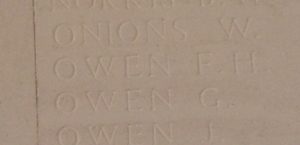
George Harry Painter, Lance Corporal, 5980, Border Regiment. George was born in 1895, the son of Leslie Tom Painter and Hannah Painter (nee Adams), of Castle Hill, Builth Wells. George worked as a domestic gardener prior to enlisting at Builth Wells into the Brecknockshire Battalion, South Wales Borderers on 5 September 1911 and attended the annual TA summer camp the following year. He then sought his discharge from the battalion before leaving Builth to work in Cumberland and enlisted at Keswick into the Border Regiment soon after the outbreak of war. George was drafted to France on 22 March 1915, joining the 2nd Battalion, Border Regiment, which was attached to 20 Brigade, 7th Division. The division was rebuilding following terrible losses during the disastrous Battle of Neuve Chapelle earlier that month. The division then moved to billets at Fort D’Esquin, where it enjoyed several weeks rest behind the lines before returning to the front by 7 April, before being moved in position to take part in the Battle of Aubers Ridge, where the Division launched an assault against the village of Aubers on 9 May 1915. No gains were made on the opening day, due to inadequate artillery support, then on 15 May 1915 the 7th Division took part in another assault, against the village of Festubert. Very heavy casualties were again suffered during the coming days, before the battle was called off. The division then rebuilt again before taking part in the Battle of Loos in September. The Division took part in the initial assault north of the Vermelles-Hulluch road, facing the Quarries and a series of strong-points. Suffering badly from British cloud gas, which was not moved sufficiently by the gentle breeze, and badly cut up by German machine gun fire and artillery, the Division nonetheless seized the Quarries and only failed to penetrate the third German line due to the relative weakness of the numbers of men that got through. In December the division was relieved and moved south into the Somme sector, spending Christmas in billets scattered around villages west of Amiens. At the beginning of February, the division took up new positions facing the village of Fricourt, where its infantry battalions began the usual routines of rotating for duty in the trenches. On 19 April 1916 the 2nd Borders were in the front line at Mansel Copse when the Germans opened up a ferocious artillery bombardment upon their positions. As soon as the artillery lifted, German infantry attacked the battalions’ positions, but were beaten off. George was killed in action during the day, one of over seventy casualties suffered by the battalion. The 20-year-old is buried in Citadel New Military Cemetery, Fricourt, France.
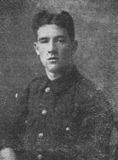
Thomas Henry Pitman, Corporal, 57583, Royal Garrison Artillery. Thomas was born at Fishguard in 1895, the son of Henry Pitman and Winifred Pitman (nee Roberts). The family had moved to Dorset House, Cwmllynfell by 1901. Thomas had worked as a miner at the Henllys Vale Colliery prior to becoming a policeman and served with the Brecon Constabulary, firstly at Brecon and then at Builth Wells. Following the outbreak of war, he enlisted at Brecon into the Royal Garrison Artillery, and was posted to the 5th/6th Trench Mortar Battery. Not much is known of Thomas’ service on the Western Front, but he was killed in action by shrapnel from a German shell on 9 May 1918, aged 23. He was originally buried in Blaireville Orchard British Cemetery, but after the war the graves within the cemetery were exhumed, and Thomas was re-interred in grave VIII. Q. 27. in Cabaret-Rouge British Cemetery, Souchez, France. His father was a Royal Navy reservist who was also on active service.
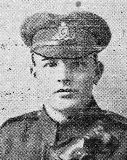
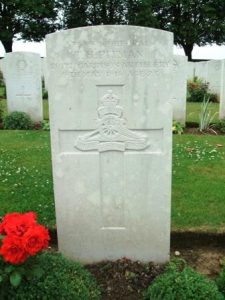
Ivor Powell, Private, 435273, Canadian Infantry. Ivor was born on 18 September 1887, the son of David Powell and Sarah Jane Powell (nee Davies), of Brynhyfryd, Builth Wells. He emigrated to Canada prior to the war and found work as a chauffeur. Ivor enlisted into the Canadian Expeditionary Force at Calgary on 4 June 1915 and was posted to the 50th Battalion, Canadian Infantry. The battalion was formed in Calgary and embarked for Britain on 27 October 1915. After completing its training on Salisbury Plain, the battalion disembarked in France on 11 August 1916, as part of the 10th Canadian Infantry Brigade, 4th Canadian Division. The division moved to the Ypres Salient for trench initiation in the Ridge Wood sector, before being transferred south at the end of September to join the great Somme offensive. The division saw its first major action during the Battle of Le Transloy from 1 to 17 October, and then fought during the Battle of the Ancre Heights from 17 October to 11 November, where it helped in the capture of Regina Trench. The division then took part in the Battle of the Ancre, which opened on 13 November, leaving its positions at the Chalk Pits in Sausage Valley that day, before taking over the front line on the following morning. The battalion sent two companies over the top on 18 November, but lost touch with the 75th Battalion, so was forced to withdraw and consolidate its gains before being forced to withdraw again to Regina Trench. Ivor was reported missing on 19 November 1916, when roll call was called at Albert. He was later deemed to have been killed in action on that date. The 29-year-old has no known grave and is commemorated on the Vimy Memorial, France.
Rees Powell, Private, 169724, Royal Air Force. Rees was born at Newbridge-on-Wye on 28 July 1876. He left home as a young boy and found work as a farm servant at Merthyr Cynog. He married Catherine Jones at Ystradfodwg in 1898, while he was working there as a coal hewer. The couple had moved to Tynllwyn, Llanfaredd by 1911 and Rees was working as a quarryman, then prior to the war they moved to the Sun Inn, Builth Wells. Rees had served with the Brecknockshire Battalion, South Wales Borderers prior to the war, having enlisted on 20 April 1908 and had attended four annual TA summer camps over the coming years: at Brecon, Porthcawl, Aberystwyth and Haverfordwest. On 1 April 1912 he completed his four-year term of engagement. He enlisted into the Royal Air Force in May 1918 and served until after the Armistice, being discharged as medically unfit on 6 December 1918. Rees then returned to his wife after being demobilised. He died of disease at Builth on 4 November 1922 and was buried in Builth Wells Cemetery four days later. The 46-year-old is not commemorated by the CWGC as a casualty of war, nor is he commemorated on either of the Builth Wells war memorials.
William Powell, Shoeing Smith, 52458, Royal Field Artillery. William was born at Builth Wells in 1881, the son of William Powell and Hannah Powell. He left home as a young man to find work as a Shoeing Smith in the South Wales coalfields and in 1910 married Ceridwen Evans, of 18, Duffryn Street, Pontlottyn. William enlisted into the Royal Field Artillery soon after the outbreak of war and with his experience of smithing, soon gained the rank of Staff Sergeant. He was posted to the 55th Brigade Ammunition Column, which was attached to the 10th (Irish) Division and embarked for Gallipoli to join the unit on 25 October 1915. The brigade was evacuated from Gallipoli via Mudros when the British force pulled out and arrived at Alexandria on 3 January 1916, then transferred to the 13th (Western) Division for operations in Mesopotamia and landed at Basra on 17 March 1916, as part of the expanding Mesopotamian Expeditionary Force, which had been formed to aid the besieged garrison at Kut-al-Amara. William became ill soon after arriving, and he died of enteric fever on 30 July 1916. The 37-year-old is buried in Amara War Cemetery, Iraq. He is not commemorated on either of the Builth Wells war memorials.
Marcus Tom Pratt, Boatswain, Mercantile Marine. Marcus was born at Stourport, Worcestershire in 1892, the son of John Acton Pratt and Amelia Georgina Pratt (nee Brookes-Finch). The family came to live at High Street, Builth Wells by 1901. Marcus became a member of the Builth Church Lads Brigade, and played football and hockey for the town, as well as becoming a chorister at St. Mary’s Church. He was already serving with the 1st Volunteer Battalion, South Wales Borderers when the battalion became the Brecknockshire Battalion following the formation of the Territorial Army in 1908 and continued to serve with the Brecknocks as a bugler, attending the annual TA summer camps at Brecon and Porthcawl over the coming years. Marcus was working at Ruboy Farm, Rednal, Birmingham when war erupted and enlisted into the Mercantile Marine soon afterwards, before being posted aboard the London registered SS Romny. On 11 February 1918 Romny left Swansea Docks for Rouen, laden with a cargo of coal. Soon after her departure, Marcus’ body was found floating in the docks. A subsequent inquest found that there were no marks on his body and that he had drowned. The remains of the 24-year-old were collected by his brother, who was home on leave from France, and brought home for burial in St. Mary’s Churchyard at Builth. Soon afterwards, on 26 February 1918, Romny, on her return voyage from Rouen to Swansea in ballast, was sunk by the German submarine UB-74 some ten miles NNE of Cape Barfleur, with the loss of nine lives. Marcus is not commemorated as a casualty by the CWGC, as he did not die due to enemy action.
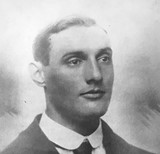
Frederick Thomas Price, Private, 510474, Royal Army Medical Corps. Frederick was born in 1894, the son of Henry Thomas Price and Susan Price (nee Hamer), of The Greyhound Hotel, Builth Wells. He was educated at Llandovery College from 1908 to 1910, before becoming a bank clerk. Frederick was living at Surbiton, Surrey and employed by the National and Provincial Bank when War broke out in August 1914. He enlisted immediately, and joined the Royal Army Medical Corps, being posted to the 2/2nd (London) Field Ambulance. Frederick served on the Western Front from January 1915 and saw action at Ypres and Loos during 1915 and on the Somme in 1916. During the Battle of Passchendaele in 1917, Frederick was serving as a stretcher-bearer at a Field Dressing Station near Chateau Wood, Ypres. The RAMC stretcher-bearers had to carry the wounded across a rough duckboard track to the Dressing Station, where one slip could result in almost certain death by drowning in the Flanders mud. Such was the danger of drowning that a decision was made to evacuate the casualties only in daylight, and it was due to this fact that Frederick was killed by enemy shellfire while performing his hazardous duties on 16 August 1917. He was 23 years old, and is buried in Menin Road South Military Cemetery, Ypres.
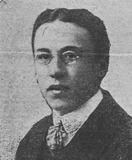
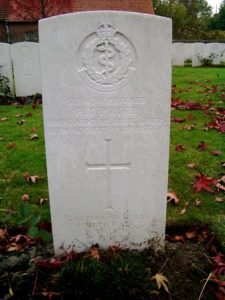
David James Price, Private, 12080, South Wales Borderers. David, who went by the name of James, was born in 1892, the son of James Price and Esther Price (nee Walters), of 9, Bank Square, Builth Wells. He worked as a labourer prior to enlisting at Brecon into the South Wales Borderers soon after the outbreak of war. James was drafted to France in the spring of 1916, joining the 2nd Battalion, South Wales Borderers. The battalion was attached to 87 Brigade, 29th Division and had landed at Marseilles following service in China, Gallipoli and Egypt on 15 March and entrained for the Somme sector, taking up positions near Beaumont Hamel, facing Y-Ravine. The Division had an arduous time here over the coming months, before taking part in a suicidal assault on 1 July 1916, on the opening day of the Somme offensive. The 2nd SWB alone suffered some 384 casualties on that day alone. Although severely depleted, the Division remained in the line here over the coming weeks, in trying conditions. The Division was then pulled out of the line to rest and rebuild before moving back into the line and taking part in the latter stages of the Somme offensive. The Division wintered on the Somme, in atrocious conditions, holding the line near Morval. On 26 January 1917 the 2nd SWB moved into support positions to aid an assault planned for the following morning by the 1st Border Regiment and 1st Inniskilling’s. The two battalions attacked at dawn on 27 January 1917, and the 2nd SWB followed up the attack, mopping up any German positions which had not been cleared. James was killed in action during the day, following a heavy artillery barrage laid down onto the battalion by the Germans. The 25-year-old has no known grave and is commemorated on the Thiepval Memorial, France.
Lawrence Price, Private, 28244, Welsh Regiment. Lawrence was born in 1892, the son of William Price and Rebecca Price (nee Davies), of 5, Castle Hill, Builth Wells. Lawrence had left home as a young man to go to sea with the Mercantile Marine and by 1911 was lodging in Liverpool. He returned home following the outbreak of war and enlisted at Brecon into the 2/1st Brecknockshire Battalion, South Wales Borderers on 24 October 1914. Lawrence then left the Brecknocks to enlist into the 18th Battalion, Welsh Regiment. The battalion was raised in January 1915 as a Bantam Battalion, made up of men of below average height, and initially went to Porthcawl attached to the 43rd (Welsh) Division. During July 1915 the battalion moved to Prees Heath to join 119 Brigade, 40th (Bantam) Division and landed in France with the Division in June 1916. The Division moved to positions around Lillers before taking over the North Maroc Sector, near Loos, for trench initiation and once acclimatised was left to hold the sector itself over the coming months. The infantry battalions of the Division then began the usual routines of rotating for duty in the trenches: normally four days in the front line; four in support and four in reserve. On 14 August 1916 the battalion was holding the left Calonne subsector near Loos when German aircraft dropped a cluster of aerial darts onto their positions. Lawrence was the only man killed, whilst five others were wounded during this attack. The 24-year-old was originally buried in Cite Calonne Military Cemetery, but the graves within the cemetery were exhumed in January 1921, and re-interred in Loos British Cemetery, France.
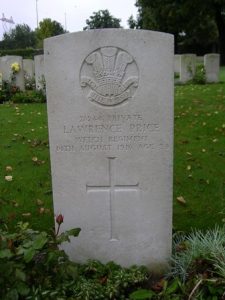
David Williams Pugh, Second Lieutenant, King’s Own Yorkshire Light Infantry. David was born in 1893, the son of David Pugh and Margaret Ann Pugh (nee Pugh), of Oaklands, Builth Wells. His father was a tailor and David followed him into the trade. His mother married David Thomas Jones in 1901 and by 1911 David was living with his mother and step father at 28, East View, Deepdale, Preston, where he worked as a tailor. David enlisted into The King’s (Liverpool Regiment) soon after the outbreak of war. He embarked for France on 16 March 1917 and was posted to the Labour Corps. He served in France for almost nine months in the ranks, before being commissioned as Second Lieutenant on 17 December 1917 and after completing his officer training was posted to the 15th Battalion, King’s Own Yorkshire Light Infantry. The battalion initially served as a Garrison Battalion, on guard duty before being attached to 120 Brigade, 40th (Bantam) Division in July 1918, when it converted to a front-line infantry unit. The division had been decimated during the German offensives of Spring 1918 and was being rebuilt at Buysscheure, near St. Omer. The division then took over the Hazebrouck Defences. To the south, the Allies launched their great offensive on 21 August and began driving towards the Hindenburg Line. Two days later, the 15th KOYLI launched an assault from its positions at Pont Rodin, consolidating its gains before the division advanced again on 25 August, thus beginning the great advance in Flanders, recapturing all the land gained by the Germans in April 1918. The division had reached Armentieres by 5 October and David joined the battalion the following day, among a draft of officers from England, and was immediately put to work on the following morning, 7 October 1918, being ordered to reconnoitre for A Company. The 25-year-old was killed in action that day, whilst carrying out his first work as an officer, together with one of his men. Their burials were found on the battlefield after the war and both men were exhumed and re-interred in Houplines Communal Cemetery Extension, France.
Roger James Pugh, Private, 55073, Royal Welsh Fusiliers. Roger was born in 1892, the son of John Pugh and Winifred Mary Pugh of Oak Cottage, Llyswen. He worked as a domestic gardener prior to the war. Roger enlisted at Brecon into the Monmouthshire Regiment, but upon being drafted to France in the summer of 1916 was transferred to the 1st Battalion, Royal Welsh Fusiliers, which was on the Somme, attached to 22 Brigade, 7th Division. The Division had taken part in the opening assault of the Somme offensive on 1 July 1916, advancing from positions near Bois Francais, near Fricourt, and capturing the village of Mametz, one of the few successes of 1 July 1916. The battalion then took part in further attacks to push forwards, to the south of Mametz Wood, and upon being relieved, witnessed the troops of the 38th (Welsh) Division moving forward to launch its assault on Mametz Wood. On 14 July, with the wood taken, the 7th Division moved back into the line, with orders to capture Bazentin-le-Petit, before taking part in the terrible attacks on High Wood over the coming days. On 22 July the 1st RWF was relieved, moving back into reserve to rest and rebuild at La Chaussee. By 12 August the battalion had moved forwards to Dernancourt, and on 26 August marched further forward, to take part in the Divisions assault on Ginchy. The Division saw heavy fighting over the coming days, before the 1st RWF had another short break, but on 1 September the battalion received orders to push forwards again to launch a fresh assault on Ginchy from Montauban Alley. On 3 September 1916 the 1st RWF launched its assault, but suffered severe casualties, with over 200 officers and men killed, wounded or missing. Roger was wounded during the latter stages of the Somme offensive and was evacuated home for treatment. He came home to Llyswen on furlough in February 1917 before returning to France to re-join his battalion. By the time he returned to France, the Germans were in the process of withdrawing to the Hindenburg Line, to shorten the front, enabling them to release more troops. The 7th Division followed the withdrawal, before reaching positions facing the Hindenburg Line near Bullecourt. The first attacks on Bullecourt began on 11 April 1917 and raged over the coming weeks. Roger was killed in action during an assault by the 1st RWF on 14 May 1917. The 23-year-old has no known grave and is commemorated on the Arras Memorial, France.
Hananiah Rees, Signaller, Wales/Z/3488, Royal Naval Volunteer Reserve. Hananiah was born on 21 September 1895, the son of William Rees and Naomi Rees (nee Walters), of The Smith Arms, Pengam. He had been educated at Pengam Grammar School, before gaining a scholarship to Goldsmith College, London and upon returning to Wales gained work as a schoolteacher and had played football for Builth Wells for several years prior to the war. Hananiah enlisted into the Royal Naval Volunteer Reserve on 24 August 1916 and was posted to HMS Victory VI at Crystal Palace for training, specialising as a signaller. Hananiah was posted to HMS Pembroke I on 7 May 1917, then on 1 October was posted to HMS Vivid III, before being posted to HMS Egmont, from where he was detached aboard the defensively armed steamer SS T. R. Thompson. On 29 March 1918, T. R. Thompson was en-route from Benisaf, Algeria to Middlesbrough with a cargo of 5,600 tons of iron ore, when she was torpedoed and sunk by the German submarine UB-57, some seven miles south of Newhaven. Hananiah was among the 33 lives lost in the sinking. The 22-year-old has no known grave and is commemorated on the Plymouth Naval Memorial, Devon. Hananiah is not commemorated on either of the Builth Wells war memorials.
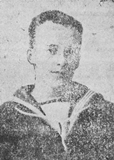
Cyril Evan Robinson, Second Lieutenant, Royal Air Force. Cyril was born at Manchester on 12 August 1899, the son of Evan George Robinson and Mary Louise Robinson (nee Griffiths). The family moved to Station Road, Llanelwedd in 1912, and Cyril worked for his father as an assistant ironmonger. He enlisted into the Royal Flying Corps and after gaining his pilots wings at the Aeronautical College at Oxford was commissioned as Second Lieutenant in December 1917, before being posted to 27 Squadron, RFC in France. The squadron had originally been equipped with the Martinsyde Elephant fighter but switched to a bomber role and re-equipped with Airco DH.4s, flying missions in support of the British offensive at Cambrai, and low-level missions against the attacking German troops during the Spring Offensive of 1918. It started to receive De Havilland 9 bombers in July 1918, but as these proved to be inferior to the DH.4, managed to keep some of its DH.4s until the end of the war. Cyril joined the squadron in July 1918. On 24 July 1918 he took off from the squadrons base at Ruisseauville, a village about 20 miles west of Bethune, flying DH9, serial C6340, with Second Lieutenant William Telfer aboard. Not long into their flight, at an altitude of 600 feet the aircraft stalled and crashed into the ground near Coulommiers, killing both men instantly. Cyril was just 19 years old and is buried next to William in Coulommiers Communal Cemetery, France.
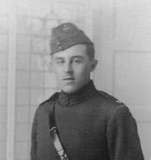
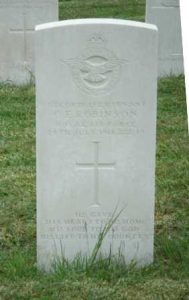
William John Rees Scully, Sergeant, 18916, Welsh Regiment. William was born in 1891, the son of Jeremiah Scully and Margaret Scully (nee Rees), of 1, Leisure Hour Court, Merthyr Tydfil. He enlisted into the 13th Battalion, Welsh Regiment at Bargoed soon after the outbreak of war. The battalion was raised at Cardiff on 23 October 1914, moving to Rhyl to join 129 Brigade, 43rd (Welsh) Division. On 29 April 1915 the formation became renumbered to 114 Brigade, 38th (Welsh) Division, before moving to Winchester in the summer of 1915 to complete its training. The Division moved to France on 2 December 1915 and moved to the Nursery Sector near Fleurbaix for trench initiation alongside the Guards Division. The Division then held a sector of the line near Cuinchy before marching south to the Somme sector in June 1916 to take part in the assault on Mametz Wood. The first attack on the wood was launched on a two-battalion front on 7 July, but failed, and the Divisional Commander, Sir Ivor Philipps, was replaced before the Division attacked again on a two Brigade front on 10 July 1916. After two days of ferocious hand-to-hand fighting, the wood was cleared up to its northern edge, before the battered Division was relieved. It then took over a section of the front at Hébuterne before moving to the Ypres Salient and taking over the Canal Bank sector at Boesinghe. The infantry battalions of the Division then began carrying out the normal pattern of rotation in the trenches, four days in the front, four in support and four in reserve, whilst also working on trench improvement, digging new trenches, and also carrying out regular patrols and trench raids. On 31 July 1917 the Division launched its famous assault on the Pilckem Ridge, capturing Iron Cross and reaching its objective of the Steenbeek, then played a supporting role in the Battle of Langemarck. William then came home on leave and on 27 August 1917 married Dorothy Nellie Charlton, the daughter of Richard and Thirza Charlton, of Builth Wells. By the time William returned to France, the 38th (Welsh) Division had been transferred to the Sailly-sur-la-Lys sector and remained in the area over the winter before being moved to positions north of Albert, at Bouzincourt Ridge, at the end of March 1918, relieving the battered 2nd and 47th Divisions. It held this sector, again carrying out minor operations and trench raids, over the coming months. William was in the trenches here on 15 July when the area was subjected to a barrage of gas shells by German artillery. William suffered severe wounds from inhaling the gas and was evacuated to hospital in Rouen where he died of gas poisoning on 19 July 1918. The 26-year-old was buried in St. Sever Cemetery Extension, Rouen, France. William is not commemorated on either of the Builth Wells war memorials.
Arthur Egerton Spencer, Lieutenant, Sherwood Foresters (Notts and Derby Regiment). Arthur was born at Torrington, Devon on 24 March 1896, the son of Doctor Edward Macready Spencer and Blanche Mary Spencer (nee Alexander). His parents moved to Builth Wells by 1912. Arthur was educated at Worcester Royal Grammar School before gaining a place at Keble College, Oxford, where he joined the Officer Training Corps. Arthur was commissioned from the OTC as Second Lieutenant into the 3rd Battalion, Sherwood Foresters on 12 March 1915 and after completing his officer training was posted to the 10th Battalion, Sherwood Foresters, which was attached to 51 Brigade, 17th (Northern) Division at West Lulworth. In June 1915 the division moved to Winchester to complete its training before landing in France on 14 July 1915, moving to the southern area of the Ypres salient for trench initiation and training. Here the division took part in the fighting at the Bluff during February 1916 before moving south to the Armentieres Sector, where it spent several months before moving to the Somme at the beginning of June 1916, to prepare for the forthcoming Somme offensive. The Battle of the Somme opened at 05.20 on 1 July 1916, with the blowing of a series of vast underground mines. Ten minutes later the infantry attacked en masse, but in many instances were mown down by machine-gun fire. Arthur’s battalion was at Morlancourt on the opening day, then in the afternoon moved up to Becourt to prepare to join the fray. On the following day, 2 July 1916, the battalion supported an assault by its brigade upon the village of Fricourt, which was taken at heavy cost. The 10th Sherwood Foresters then carried the advance through Fricourt Wood but became held up at Railway Alley by heavy fire. Arthur was sent forward with a small party of men to cut the enemy wire defences, but they came under heavy fire and had to withdraw. Arthur fell into the enemy trench and was killed by a grenade. The 20-year-old was reportedly buried on the following day by his CO after the trench had finally been taken, however he has no known grave, so is commemorated on the Thiepval Memorial, France. He is also commemorated on a family memorial at St Eustachius Church, Tavistock.
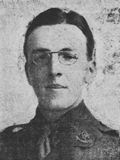
Harold Symonds, Private, 355180, Royal Welsh Fusiliers. Harold was born in 1894, the son of Edward Symonds and Celia Symonds (nee Roberts), of Dingle Cottage, Old Ross Road, Much Marcle. He came to Builth in about 1912 to work as a groom for F. A. Phillips, of Tynygraig. Harold enlisted into the Montgomeryshire Yeomanry at Llandrindod Wells soon after the outbreak of war. On 5 August 1914 the Montgomeryshire Yeomanry was mobilised at Welshpool, as part of the South Wales Mounted Brigade, before moving via Hereford to Thetford, to join the 1st Mounted Division. On 4 March 1916 the 1st Mounted Division sailed for Egypt to join the EEF. On 4 March 1917 the battalion merged with the Welsh Horse Yeomanry to form the 25th (Montgomery & Welsh Horse Yeomanry) Battalion, Royal Welsh Fusiliers, as part of the newly formed 231 Brigade, 74th (Yeomanry) Division. The Division assembled in Egypt as part of the EEF, before crossing the Suez Canal into the Sinai, and saw its first major action during the Second Battle of Gaza. The battle was a failure, and the EEF was re-organised under a new commander, Sir Edmund Allenby. Harold was killed on 28 June 1917, during this period. The 22-year-old is buried in Gaza War Cemetery. Harold is not commemorated on the Builth Wells war memorial.
George Thomas, Private, 12068, South Wales Borderers. George was born in Cilfynydd in 1891, the son of David Thomas and Louisa Thomas (nee Games). His parents were from Builth Wells, and by 1901 the family had moved back home, to live at Rhydithon, Builth Wells. George worked as an outfitter’s assistant prior to the war. He enlisted into the South Wales Borderers at Birmingham soon after the outbreak of war, and in the spring of 1916 was drafted to France, joining the 5th Battalion, South Wales Borderers, which was the Pioneer Battalion to the 19th (Western) Division. The division had its baptism during the opening of the Battle of Loos on 25 September 1915 and remained in the area over the winter before moving south to the Somme in June 1916. It then took part in the second wave of the attack on Ovillers-La Boiselle on 1 July, capturing the village at heavy cost. It then fought through the Somme Battles of Pozieres and the Ancre in 1916. In 1917 the Division moved North to Ypres, taking part in the Battle of Messines. After a brief rest, where the Division rebuilt its strength, it then took part in the main Passchendaele offensive, which was launched on 31 July 1917. By October the Division had moved to the Merris area, and carried out several weeks of training whilst rebuilding, before moving south in the first week of December, taking over a section of the front line in the Ribecourt Sector. The Division wintered here, holding this sector over the coming months. At dawn on 21 March 1918 the Division was hit hard by the opening assault of the German Spring offensive, Operation Michael, and suffered terrible casualties during a fighting withdrawal over the coming days. The battered Division was relieved by the Australians, before being sent to the quieter Messines sector again on 30 March, to rest and rebuild. Unfortunately, the second phase of the German offensive, Operation Georgette, was launched along the Lys valley on 9 April, and the Division once more became embroiled in desperate fighting. George was killed in action here on 11 April 1918 as the division fought gallantly to attempt to stem the German advance. The 26-year-old has no known grave and is commemorated on the Tyne Cot Memorial, Belgium.
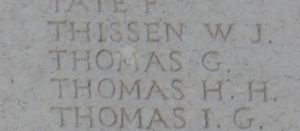
Sidney Henry Vest, Sergeant, 82535, Royal Engineers. Sidney was born in Llangammarch Wells in 1876, the son of William Vest and Margaret Vest (nee Owens). The family moved to Builth Wells by the mid 1880’s and Sidney married Margaret Rees there in 1898. The couple had two children over the coming years, but sadly Margaret died in 1906. After her death, Sidney went to work as an assistant underground timberman in the South Wales coalfields and married Elizabeth Powell there in 1908, the couple settling at 36, Mount Libanus, Treherbert, where their daughter was born the following year. Sidney enlisted at Pentre into the Royal Engineers soon after the outbreak of war and was posted to France on 3 December 1915, joining the 14th Brigade Signal Sub Section, RE, which was attached to the 5th Division. By March 1916 the Division was holding the line between St. Laurent-Blangy and Vimy, near Arras, then following the opening of the Somme offensive moved south and took part in the fighting for High Wood, then remained here throughout the offensive. On 5 October, after suffering heavy casualties, the Division moved to Festubert, where it remained until March 1917. It next saw action at the Battle of Arras, fighting at the Battle of Vimy in April 1917, and the attack on La Coulette, then on 3 May fought in the Third Battle of the Scarpe, capturing Oppy Wood. On 7 September, the division moved north to join the great offensive in Flanders against Passchendaele Ridge, seeing heavy fighting at the Battle of Polygon Wood, then at Broodseinde and Poelcapelle in September, and on 26 November fought in the Second Battle of Passchendaele. The division was then transferred to Italy to reinforce the thinly stretched Italians north of the Piave but was recalled to France at the end of March 1918 following the launching of the German Spring offensive on 21 March. The Division moved to Flanders and played a part in the Defence of Nieppe Forest. On 14 August, the Division was withdrawn for a rest and placed in GHQ Reserve, but two weeks later joined the great Allied offensive towards the Hindenburg Line that ultimately won the war. Sidney was wounded during the last days of the war and died of his wounds on 1 November 1918. The 42-year-old is buried in Awoingt British Cemetery, France. His cousin, Thomas Vest, had been killed in 1917.
Thomas Robert Vest, Private, 241501, North Staffordshire Regiment. Thomas was born in 1896, the son of William Price Vest and Catherine Vest (nee Jones), of 25, Oaklands, Builth Wells. He worked as a grocer’s assistant at Uttoxeter prior to enlisting there into the army in January 1916. He was posted to the 2/6th Battalion, North Staffordshire Regiment and was sent to Ireland on garrison duties with the battalion, which moved to Dublin as part of 176 Brigade, 59th Division in Luton area. July 1915 to St. Albans area. After serving throughout the Irish Rebellion, the division was recalled to England in January 1917 and on 25 February 1917 landed in France. The division then followed the German Retreat to the Hindenburg Line in March 1917 and moved to Ypres later that year to take part in the great offensive against Passchendaele Ridge. The division was transferred from Ypres to the Arras sector at the end of September, to join the forces being assembled to assault the Hindenburg Line in front of the city of Cambrai. The Battle of Cambrai opened on 20 November 1917 and was initially successful, with the Hindenburg Line being broken by the massed use of tanks, supported by infantry. The 2/6th North Staffs were in reserve at Heudicourt, then on 27 November moved forwards to Flesquières, before taking over the front line in Bourlon Wood on the following morning. The battalion was heavily shelled on the following day, then again on the morning of 30 November 1917, before the Germans launched an overwhelming counterattack. Thomas was killed in action by artillery fire that day. The 22-year-old has no known grave and is commemorated on the Cambrai Memorial, Louverval, France. His cousin, Sidney Vest, died of wounds near here just a year later.
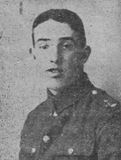
David Rees Watkins, Private, 29723, South Wales Borderers. David was born on 21 July 1890, the son of Margaret Watkins, of Road Side Cottage, Llanfihangel Brynpabuan. He married Daisy Smith in 1914 and the couple set up home at 11, Oaklands, Builth Wells. David enlisted into the South Wales Borderers in the spring of 1916 and upon being drafted to France was posted to the 11th Battalion, South Wales Borderers, which was attached to 115 Brigade, 38th (Welsh) Division. David probably joined the battalion after the division had taken part in its epic assault on Mametz Wood in July 1916. The division then took over a section of the front at Hébuterne before moving to the Ypres Salient and taking over the Canal Bank sector at Boesinghe. The infantry battalions of the Division then began carrying out the normal pattern of rotation in the trenches, four days in the front, four in support and four in reserve, whilst also working on trench improvement, digging new trenches, and carrying out regular patrols and trench raids. On 31 July 1917 the Division launched its famous assault on the Pilckem Ridge, capturing Iron Cross and reaching its objective of the Steenbeek, then played a supporting role in the Battle of Langemarck. David was badly wounded during the fighting for Pilckem Ridge and after treatment at a nearby Field Ambulance, eventually reached a hospital on the French coast before being evacuated back to Britain. Upon being discharged from the army as medically unfit on 27 November 1917, he returned to his wife Daisy at Builth, fathering a daughter with her. As well as having been wounded, and losing an eye, David had also contracted tuberculosis during his time in France. His health failed him after the war, and he died of tuberculosis at Builth on 27 June 1924. The 34-year-old was buried in Builth Wells Cemetery the following day. David is not commemorated on either of the Builth Wells war memorials.
John Henry Watkins, Private, 88870, Royal Welsh Fusiliers. John was born in 1885, the son of John Watkins and Jane Watkins (nee Davies), of West Street, Builth Wells. He married Ellen Full, a laundress at Talgarth Asylum, at Talgarth on 5 July 1913 and the couple set up home at 2, Regent Street, Talgarth. John worked as a plumber prior to the war. He enlisted into the Royal Welsh Fusiliers during the spring of 1918 and was drafted to France that summer, joining the 9th Battalion, Royal Welsh Fusiliers, which was attached to 58 Brigade, 19th (Western) Division. John joined the battalion in time to take part in the great 100 days offensive which won the war. He was wounded just prior to the Armistice, and was evacuated to the hospital at Rouen, where he died of his wounds on 26 November 1918. The 33-year-old is buried in St. Sever Cemetery Extension, Rouen, France.
Ronald Ramsay Wearn, Rifleman, 550763, London Regiment. Ronald was born in 1889, the son of Christopher Wearn and Sarah Wearn (nee Ramsay), of Gwynfryn, Park Road, Builth Wells. His father was the headmaster of Builth Wells Council School. After completing his education, Ronald began work as a clerk for the London & Provincial Bank at Sidcup. He enlisted into the 16th Battalion, London Regiment (Queen’s Westminster Rifles) in August 1914. The battalion had mobilised at Westminster following the outbreak of war, before embarking for France on 3 November 1914, joining 18 Brigade, 6th Division. Ronald embarked for France among a reinforcement draft for the battalion on 4 July 1915, joining the battalion in the Ypres Salient, where it was holding the line between Potijze and Wieltje and was rebuilding following heavy fighting during the Action of Hooge the previous month. During the coming month the division remained in this area, its infantry battalions rotating for duty in the trenches as well as carrying out other labouring work. Ronald suffered gas inhalation wounds here in October and was hospitalised, returning to Britain for treatment by 13 December 1915. It was not until 5 January 1917 that he returned to France and re-joined his battalion at Bout Deville, where it was resting and training out of the line and had transferred to 169 Brigade, 56th (London) Division. The division then moved back into the line near Gommecourt at the beginning of March and followed the German withdrawal to the Hindenburg Line over the coming weeks. Ronald was evacuated to hospital after becoming ill during this period, and he died of septicaemia on 10 April 1917. The 28-year-old was buried in Mont Huon Military Cemetery, Le Treport, France.
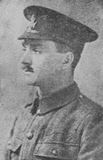
John Wheeler, Sapper, 386640, Royal Engineers. John was born at Abertillery in 1897, the son of William Whitehall Wheeler and Alice Wheeler (nee Stanton). By 1901 he was living with his grandmother, Mary Stanton, at 9, Castle Row, Builth Wells, then by 1911 he was an inmate at Brecon Workhouse, where he was working as a baker’s errand boy. John enlisted at Pontypridd into the Royal Engineers soon after the outbreak of war and embarked for France on 14 December 1914 with the 4th Siege Company, Royal Monmouthshire Royal Engineers. The company had formed at the depot at Monmouth before moving to Chatham, then on 13 December 1914 departed for Southampton where it embarked for France, landing on the following day at Le Havre before proceeding to the Ypres Salient, setting up its HQ at Tatinghem and began work on constructing trenches and defences. John was at work near Vlamertinghe on 9 May 1917 when he was killed by enemy shellfire. The 19-year-old is buried in Brandhoek Military Cemetery, Belgium.
William Charles Wheeler, Private, 57074, Manchester Regiment. William was born at Abertillery in 1899, the son of William Whitehall Wheeler and Alice Wheeler (nee Stanton). By 1901 he was living with his grandmother, Mary Stanton, at 9, Castle Row, Builth Wells, then by 1911 he was an inmate at Brecon Workhouse, where he was listed as a school pupil. William enlisted into the army at Brecon in 1917 and upon being drafted to France was posted to the 12th (Duke of Lancaster’s Own Yeomanry) Battalion, Manchester Regiment. The battalion was attached to 52 Brigade, 17th Division and William probably joined it at Elverdinghe, where the division was holding a section of the line facing Passchendaele Ridge. The battalion remained at Elverdinghe for much of October, carrying out working parties for the battalions in the front line then on 9 November moved into the front line, where it was hit hard by a German counterattack on the following day, the final day of the Passchendaele offensive. Just over a month later, the division was relieved and moved south, reaching Achiet-le-Petit by 15 December, moving into 3rd Army Reserve. The division then took over a section of the front line in the Flesquières Salient, where it spent the winter. At 04.50 on 21 March 1918 the Germans opened up a ferocious artillery bombardment on a section of the Western Front running south from Croisilles to La Fère and at around 06.30 German infantry attacked this section, en masse. The 12th Manchester’s saw little fighting that day as the Germans attacked units on its flanks, but on the following day was forced to withdraw to hold the Havrincourt Defences where it fought off four German attacks that day. The Germans then broke through to the north, so on 23 March the battalion was ordered to withdraw again to the old British front line at Rocquigny. Heavy fighting raged over the coming days with the battalion suffering terrible casualties as it was forced to withdraw to Flers on 24 March 1918. William was killed in action during the terrible fighting that day. The 19-year-old has no known grave and is commemorated on the Arras Memorial, France.
Douglas Leo White, Private, 355217, Royal Welsh Fusiliers. Douglas was born at Vaynor in 1891, the son of Thomas White and Annie White (nee Thomas). His father was a Police Constable for Breconshire Constabulary and the family had moved to Erwood Police Station village by 1898. Douglas was residing at Duhonw Lodge, Builth Wells by 1911, where he worked as an assistant gamekeeper. He enlisted into the Montgomeryshire Yeomanry at Llandrindod Wells on 25 August 1914. The battalion had mobilised at Welshpool, as part of the South Wales Mounted Brigade, before moving via Hereford to Thetford, to join the 1st Mounted Division. On 4 March 1916 the 1st Mounted Division sailed for Egypt to join the EEF. On 4 March 1917 the battalion merged with the Welsh Horse Yeomanry to form the 25th (Montgomery & Welsh Horse Yeomanry) Battalion, Royal Welsh Fusiliers, as part of the newly formed 231 Brigade, 74th (Yeomanry) Division. The Division assembled in Egypt as part of the EEF, before crossing the Suez Canal into the Sinai, and saw its first major action during the Second Battle of Gaza. The battle was a failure, and the EEF was re-organised under a new commander, Sir Edmund Allenby, before launching the Third Battle of Gaza on the night of 31 October 1917. This assault was launched along a winder front, running from Gaza to Beersheba, and this time the EEF prevailed, opening the door to Jerusalem, which surrendered on 8 December. The Division then took part in the drive north into Syria, but as a result of the heavy losses suffered in France, following the launching of the three German Spring offensives from 21 March 1918, was sent to France, landing in Marseilles on 7 May 1918. The Division underwent a system of training, to prepare it for the vastly different conditions on the Western Front, before taking over a section of the front in the St. Floris Sector. At the end of August, the Division moved south to the Somme sector, to join the great offensive, and on 18 September took part in an assault on positions near Lempire and Ronssoy, which formed part of the outer defensive line for the Hindenburg Line. Douglas was killed in action during the heavy fighting that day. The 25-year-old is buried in Ronssoy Communal Cemetery, France. His widowed mother had only just received the new of the death of her other son, John, when she received news of the death of Douglas. His brother John had been killed on 21 August 1918. He had never lived at Builth, so is not commemorated there.
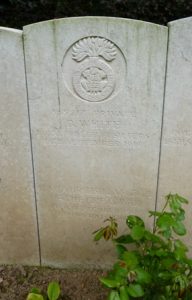
Cyril Williams, Private, 2272, South Wales Borderers. Cyril was born in 1893, the son of John Williams and Eleanor Williams (nee Powell), of Maescwm Farm, Builth Wells. His father died in 1901, so Cyril played an important role in running the family farm as he grew up. He had enlisted at Brecon into the Brecknockshire Battalion, South Wales Borderers on 15 February 1909 and over the coming years attended the annual TA summer camps at Porthcawl, Aberystwyth, Haverfordwest and at Hereford. The battalion was attached to the Welsh Division and moved to Pembroke Dock upon mobilisation. It was then withdrawn from the Division and on 29 October 1914 sailed from Southampton for Bombay, where the battalion transhipped and sailed for Aden, arriving on 16 December 1914. The battalion endured a torrid time in the heat of Aden, losing several men to heatstroke. In August 1915 the battalion moved to India on garrison duties, where it remained for the duration of the war. Cyril took ill and died of pneumonia at Mhow on 8 December 1915. The 22-year-old was buried in Mhow New Cemetery. He is also commemorated on the Kirkee 1914-1918 Memorial, India.
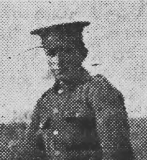
Frederick Williams, Lieutenant, Royal Air Force. Fred was born in 1895, the son of William Williams and Ann Williams, of Winstone House, Builth Wells. Frederick enlisted into the army soon after the outbreak of war and embarked for France in July 1916. He served over twelve months in France before being commissioned as Second Lieutenant into the Royal Welsh Fusiliers in August 1917, and then volunteered to transfer to the Royal Flying Corps, where he trained as a pilot. Frederick was then posted to 62 Squadron, Royal Flying Corps, which had formed at Filton on 8 August 1916 and was equipped with Bristol F2B fighter aircraft. The squadron was deployed to France in January 1918 and began operations from its base at Serny in early 1918, operating as a fighter-reconnaissance unit. The squadron transferred to the newly formed Royal Air Force soon after, due to the merging of the Royal Flying Corps and the Royal Naval Air Service and continued operations from Serny. On 6 June 1918 Frederick returning from an offensive patrol aboard his Bristol, Serial C965, when he ran into a hangar, damaging the aircraft. He was then given Bristol D8028 to fly. On 24 June 1918 he took off from Serny on an offensive patrol over Lille aboard his new aircraft. He encountered a flight of four to five enemy aircraft which he attacked and was last seen fighting against these overwhelming odds. Frederick and his navigator, Second Lieutenant Dumville were posted as missing when they failed to return from the patrol that day and were afterwards found to have been shot down and both killed. William was 22 years old when he was killed during the crash that day and was buried alongside his navigator at Thumeries, some eight miles south of Lille. The two men’s graves were exhumed in 1922, after the war, and they were both re-interred in Cabaret Rouge British Cemetery, Souchez, France.
Ernest Egerton Wright, Private, 51715, Cheshire Regiment. Ernest was the son of Jabez and Martha Wright, of Woodlands, Newbridge-on-Wye. He married Emily Davies on 18 November 1908, and the couple initially lived at Llangammarch Wells, before moving to the Toll Gate, Brecon Road, Builth Wells. Ernest enlisted into the King’s Shropshire Light Infantry at Brecon on 15 February 1916 and was posted to Shrewsbury. After completing his training, he embarked at Southampton on 19 October 1917, joining the 4th Infantry Base Depot at Rouen, initially destined for the 5th KSLI. On 25 October 1917 Ernest was instead transferred to the 15th Battalion, Cheshire Regiment, which was at Ypres attached to 105 Brigade, 35th Division. The Division had been involved in heavy fighting to the south of the Houthulst Forest and on 2 November the 15th Cheshire’s had moved to a rest camp near Proven. The Division then took over a section of the front line at Poelcapelle, where it remained over the winter. Unfortunately for the 35th Division, it was transferred south at the beginning of March 1918, reaching Suzanne, on the Somme, on 24 March, three days after the Germans had launched their great Spring offensive, and the Division was immediately sent forward to aid the troops in the front line at Maricourt. The battalion came into contact with the attacking German troops as soon as they arrived, and fierce fighting erupted. Ernest was killed in action that day, 24 March 1918, aged 33. He has no known grave and is commemorated on the Pozieres Memorial, France.
World War Two, 1939-1945
Ronald Asbrey, Signalman, 2585088, Royal Corps of Signals. Ronald was born in 1917, the son of Edward Asbrey and Mary Asbrey (nee Long), of Park Wells, Rhosferig, Builth Wells. He enlisted into the army and was posted to the Royal Corps of Signals, before being drafted out to North Africa to take part in the campaign against the Italians and the Afrika Korps. Ronald was killed at Benghazi on 27 March 1941, following the launch of Rommel’s great offensive three days earlier. The 23-year-old is buried in Benghazi War Cemetery, Libya.
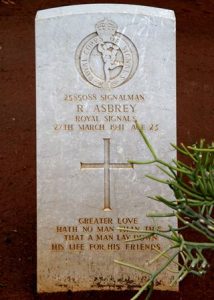
Lawrence Oliver Mackay Barstow, MiD, Second Lieutenant, 124959, Royal Horse Artillery. Lawrence was born in Paddington on 10 December 1912, the son of the prominent Civil Servant and businessman Sir George Lewis Barstow and Lady Enid Lilian Barstow (nee Lawrence). The family had a country home at Chapel House, Builth Wells. Lawrence was educated at Oxford University, graduating as Batchelor of Arts. He worked for the Anglo-American Oil Company prior to the war, before gaining a was commission as Second Lieutenant into the 5th Regiment, Royal Horse Artillery. Lawrence was obviously a highly intelligent officer, and he was accepted for service with the top-secret Special Operations Executive (SOE), which had been formed on 22 July 1940. In April 1941, in a mission codenamed Operation Yak, Peter Fleming, later the author of the James Bond novels, attempted to recruit agents from Italian prisoners of war. He met with no success, so Lawrence joined the mission and sailed for German occupied Greece aboard the RN yacht Kalanthe. On 24 April 1941, Kalanthe was in the bay of Polyaigos island, Cyclades when it was attacked and machine-gunned by German aircraft. Lawrence was killed during the attack that day. The 28-year-old has no known grave and is commemorated on the Athens Memorial, Greece. Lawrence was posthumously Mentioned in Despatches for his work with the SOE. He is not commemorated on the Builth Wells war memorial.
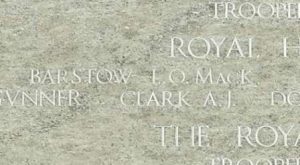
Charles Hubert Blackham, Captain, 127673, Royal Army Medical Corps. Charles was born in Dublin on 12 November 1914, the son of Richard Litton Blackham and Rachel Kathleen Blackham (nee Marsh). He trained as a doctor as a young man, then entered practise in Dublin. Charles married Idrys Mary Griffith Phillips, a nurse, from Brunswick House, Builth Wells at Builth in 1940. By then he had been commissioned as an officer into the Royal Army Medical Corps. Charles was then attached to the 2nd Battalion, Rifle Brigade and joined the battalion in North Africa, where it was attached to the 1st Armoured Division. The division played an important part in the Western Desert Campaign and was conspicuous during the Second Battle of El Alamein in October 1942 and played a prominent role in the final stages of the Tunisian Campaign. In September 1943 the 2nd Rifle Brigade transferred to the 7th Armoured Brigade in the 10th Armoured Division but transferred to the 61st Lorried Infantry Brigade in the 6th Armoured Division in May 1944 to take part in the Italian Campaign. Charles was killed in Italy on 4 June 1944. The 29-year-old was originally buried on the battlefield, but in March 1945 his grave was exhumed, and Charles was re-interred in Cassino War Cemetery, Italy. Charles is not commemorated on the Builth Wells war memorial, although his widow Idrys lived there until her death in 1980.
Irfon Rees Davies, Driver, 14513570, Royal Engineers. Irfon was born in 1924, the son of Rees Davies and Mary Selina Davies (nee King), of Bwlchyradwywynt, Builth Wells. He enlisted into the army and became a driver with 18 Movement Control Pool, Royal Engineers. Irfon was killed during the fighting on the Rhine, at some time between 20 December and 21 December 1944. The 20-year-old is buried in Schoonselhof Cemetery, Belgium. He is not commemorated on the Builth Wells war memorial.
Morley James Drew, Guardsman, 2737342, Welsh Guards. Morley was the son of Owen and Gladys Ruth Drew, of Builth Road. He enlisted into the 3rd Battalion, Welsh Guards. The battalion was formed at Beavers Camp, Hounslow on the 24 October 1941, and sailed for North Africa on 5 February 1943, joining the 1st Guards Brigade. The battalion then took part in the drive to push Rommel out of North Africa before landing in Italy early in 1944. Here it took part in the drive to push the Germans out of Italy, seeing heavy fighting at Monte Cerasola before advancing towards Rome and seeing more fighting at Monte Piccolo before attacking the Gothic Line. Morley was killed in Italy on 26 July 1944, aged 30. He is buried in Assisi War Cemetery, Italy. He is not commemorated on the Builth Wells war memorial, but at Cwmbach Llechryd.
Josiah Raymond Evans, Master, Merchant Navy. Josiah was born on 20 June 1892, the son of Francis and Sarah Evans, of Arba, New Quay. Josiah married Frances Margaret Bowers in 1938 and the couple set up home at Querida, Garth Road, Builth Wells. He had served with the Mercantile Marine during the Great War, and served again during the Second World War, becoming Master of the Cardiff registered steamer SS Coryton. On 17 February 1941, Coryton was steaming off the north east coast, after having left an Atlantic Convoy to head south for Hull. She had not long left the safety of the convoy when she was attacked by German aeroplanes, which machine-gunned the ship. Josiah decided to run the stricken ship aground in Budle Bay and ordered his crew to take to the lifeboats. He remained aboard the ship, but she broke up when a storm broke out later in the day, and Josiah was drowned. The body of the 48-year-old was recovered from the sea on the following day, after having washed ashore and was repatriated back home for burial in St. Mary’s Churchyard, Builth Wells.
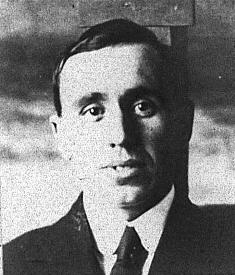
David James Gibbons, Leading Aircraftman, 1274803, Royal Air Force Volunteer Reserve. David was born in 1923, the son of Alfred Tom Gibbons and Alice Gertrude Gibbons (nee Williams), of Llwynllwyd Cottage, Builth Wells. He enlisted into the Royal Air Force Volunteer Reserve and was posted to 184 (Heavy Bomber) Wing at Salbani, India. David died in India on 5 May 1945. The 22-year-old is buried in Ranchi War Cemetery, India. David is not commemorated on the Builth Wells war memorial.
John Kenneth Glasscodine, Private, 14989830, Welch Regiment. John was born at Oswestry in 1926, the son of Wilfred Henry Portman Glasscodine and Jane Annie Maud Glasscodine (nee Wynne). The family resided at Station House, Llanelwedd prior to the war, where John’s father was Station Master. John was a member of Builth Air Training Corps prior to the war. He attempted to enlist into the Royal Air Force but was transferred to the army and posted to the 4th Battalion, Welch Regiment. The battalion was a TA unit, recruited mainly from men of Carmarthenshire and was attached to 158 Brigade, 53rd (Welsh) Division. The battalion was mobilised at the outbreak of war, when the Division moved to Northern Ireland to begin garrison duties. The Division then moved to Pembroke Dock, before moving again to the south of England, where it trained in readiness for the D-Day Landings. On 24 June 1944 the 7th RWF left England for Normandy, and landed at La Riviere near Ver Sur Mer. The Division then took part in heavy fighting over the coming weeks, as part of the effort to break-out of the Normandy beachhead, seeing heavy fighting at Évrecy, before starting the epic advance through Northern France into Belgium and Holland. On 15 September the Division forced the crossing of the Junction Canal North of Lommel, and continued to push westwards towards Elst, between Nijmegen and Arnhem, during Operation Market Garden. On 22 October the Division launched its famous assault on ‘s-Hertogenbosch, before continuing its advance to the German frontier. Between December 1944 and January 1945, the Division took part in the Battle of the Bulge, helping in the counterattack which helped save the Americans, who were under heavy pressure, then after the German offensive was broken, took part in heavy fighting to enter the Rhineland, taking part in Operation Plunder, the Rhine Crossings, in March 1945. John was killed near Weeze on 7 March 1945, during a day of ferocious fighting. The 19-year-old was originally buried at Wissen Castle at Weeze, but in October 1946 his grave was exhumed, and he was re-interred in Reichswald Forest War Cemetery, Germany.
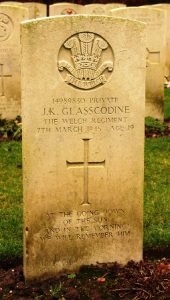
Walter Samuel Palfrey Griffiths, Pilot Officer, 61267, Royal Air Force. Walter was born at Llanelli, Carmarthenshire in 1920, the son of Benjamin Watson Griffiths and Margaret Edith Griffiths (nee Samuel), of 24, Mina Street. The family moved to Bryntirion, Builth Wells prior to the war, where Walter’s father had gained a position as tax officer for HM Customs and Excise. Walter was educated at Brasenose College, Oxford where he qualified BA in Jurisprudence. Following the outbreak of war, he enlisted into the Royal Air Force and was commissioned as Pilot Officer into the Royal Air Force on 16 February 1941. Walter then qualified as a pilot and flown Bristol Beaufort’s from No 3 Operational Training Unit at RAF Chivenor and then from RAF Abbotsinch, before being posted to 217 Squadron, Royal Air Force, which was an RAF Coastal Command unit, based at RAF St. Eval in Cornwall. On 28 September 1941, Walter took off from St. Eval, flying a Bristol Beaufort I, Serial W6501 on a raid on St. Nazaire, in France. The aircraft appears to have been intercepted by a German night fighter and was shot down in the sea. The bodies of Walter, who was just 21 years old, and one of his crew were later washed ashore and buried in La Gueriniere Communal Cemetery, France.
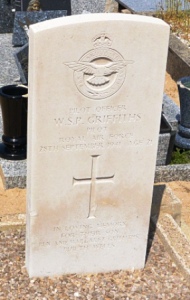
John Stuart Hallam, Lieutenant, 164847, King’s Royal Rifle Corps. John was born at Tonbridge, Kent in 1909, the son of Stuart Griffith Hallam and Frances Ann Hallam (nee Johnson). He married Rosalind Mary Pain, of Builth Wells, in Northampton in 1941. John enlisted into the army and was commissioned into the 2nd Battalion, King’s Royal Rifle Corps. The original battalion was in France with the BEF in 1940 as part of the 30th Infantry Brigade, 1st Armoured Division, and was lost whilst slowing the German advance towards Dunkirk. The battalion was reformed in the summer of 1940 and transferred to the 22nd Armoured Brigade, 1st Armoured Division before embarking for North Africa. The battalion then took part in the Battle of Gazala in May 1942 and the Second Battle of El Alamein in October 1942, then in January 1943 transferred to the 4th Armoured Brigade, 7th Armoured Division, the famous Desert Rats. John was killed on 4 January 1943, just prior to the battalion’s transfer. The 33-year-old has no known grave and is commemorated on the Alamein Memorial, Egypt. John is not commemorated on the Builth Wells war memorial. His widow, Rosalind, married Edward Thomas at Builth in 1952 and lived until 1993.
Reverend Hubert James John Harries, Chaplain, 88005, Royal Air Force Volunteer Reserve. Hubert was born in Swansea on 26 February 1907, the son of James George Harries and Elizabeth Harries (nee Thomas), of 21, Brynsifi Terrace, Swansea. He was educated at Oxford, graduating Master of Arts, before becoming a Clerk in Holy Orders and by 1939 was residing at Dolberthog, Irfon Road, Builth Wells. He volunteered to serve in the Royal Air Force Volunteer Reserve and was commissioned as a Chaplain on 19 November 1940. In 1941 Hubert married Josephine Turnbull Owen whilst home on leave. After a lengthy period serving as a Chaplain in North Africa, Hubert returned to Britain on medical grounds and was posted to 108 Operational Training Unit at RAF Wymeswold, in Leicestershire. On 18 October 1944 Hubert took communion at Wymeswold, and shortly afterwards killed himself with his service pistol. The body of the 37-year-old was taken back to Swansea, and he was buried in St. Paul’s Churchyard, Sketty. Hubert is not commemorated on the Builth Wells war memorial.
Edward Honey, Private, 14223132, The Queen’s Royal Regiment (West Surrey). Edward was born in Monmouthshire on 30 September 1915, the son of Robert William Honey and Edith Clara Honey (nee Gurney). The family moved to Builth Wells after Edward’s father gained a position there as a gamekeeper. Edward enlisted into the army and was posted to the 1/5th Battalion, The Queen’s Royal Regiment (West Surrey), a TA unit which was attached to the 131st Infantry Brigade, 44th (Home Counties) Infantry Division. The division had been in France with the BEF in 1940 and took part in the Battle of France and in the subsequent Dunkirk evacuation. Upon returning to England, the division was later sent to North Africa in mid-1942 to join the Eighth Army, taking part in the North African Campaign and then in the Italian Campaign from September 1943 after the 131st Infantry Brigade had transferred to the 7th Armoured Division. The 7th Armoured Division was then recalled to England in January 1944 to prepare for the Normandy Landings, landing on 7 June 1944, D-Day Plus 1, before taking part in the campaign to break out from Normandy. The Division then took part in the subsequent drive through Northern France into Belgium and Holland before crossing the Rhine into Germany in March 1945. Edward was killed in Germany on 5 April 1945. The 29-year-old was originally buried in an isolated grave near Halen, but in September 1947 his grave was exhumed, and he was re-interred in Rheinberg War Cemetery, Germany.
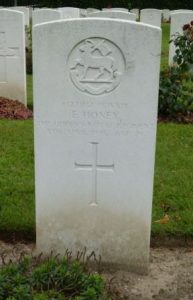
David Vincent James, Pilot Officer, 165383, Royal Air Force Volunteer Reserve. David was born in 1923, the son of William Charles James and Mabel Alice James (nee Butterfield), of Irfonddu Irfon, Bridge Street, Builth Wells. He enlisted into the Royal Air Force Volunteer Reserve and after being commissioned as a Pilot Officer in June 1944 was posted to 60 Operational Training Unit at RAF High Ercall, in Shropshire, to train as a fighter pilot. On 25 November 1944 David took off from High Ercall flying a De Havilland Mosquito FB.VI, Serial LR384 on a navigational exercise to the south coast. The aircraft suffered problems and lost control whilst over the sea off Bridport Dorset, crashing into the water and killing David and his co-pilot. David was 21 years old when he was killed that day. He has no known grave so is commemorated on the Runnymede Memorial, Surrey.
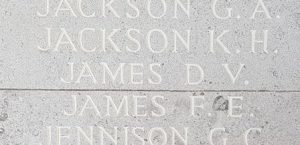
Llewelyn Albert Jenkins, Baker, Merchant Navy. Llewelyn was born in Builth Wells in 1900, the son of Albert and Elizabeth Jenkins. He married Minnie Jones at Builth in 1924 and the couple set up home at 4, Picton Street, Llanidloes. Llewellyn was a Baker and upon enlisting into the Merchant Navy retained his profession, becoming ships baker aboard the SS Orama. Orama had been built for the Orient Line in 1924, but in 1940 was requisitioned by the Admiralty and converted to a troopship. The liner transported the BEF to Norway following the German invasion, but as Norway began to fall, she left Norway to return to Britain. On 8 June 1940 Orama was intercepted by the German battleships Scharnhorst and Gneisenau some 300 miles west of Narvik and was sunk with the loss of 19 lives. Some 200 survivors were taken prisoner by the Germans. Llewellyn was 39 years old when he was killed that day and is commemorated on the Tower Hill Memorial, London.
David Morgan Price Jones, Pilot Officer, 108245, Royal Air Force Volunteer Reserve. David was born in 1914, the son of John Jones and Mary Jones (nee Williams), of 38, Oaklands, Llanddewi’r Cwm, Builth Wells. He was Head Boy at Builth Wells County School and had gained his degree prior to the war, graduating Batchelor of Arts before becoming an editor for the Wyeside Magazine. David enlisted into the Royal Air Force Volunteer Reserve soon after the outbreak of war and trained as an Observer, being commissioned as Pilot Officer on 11 October 1941 and was posted to 149 (East India) Squadron, Royal Air Force, which was an RAF Bomber Command unit, based at RAF Lakenheath, in Suffolk. On the night of 5 June 1942 David took off from Lakenheath aboard a Short Stirling I, Serial W7508, which joined a large bomber group despatched to strike targets at Essen, Germany. On the following morning, 6 June 1942, the Stirling was intercepted by a German night fighter and was shot down, crashing into the ground at L’ecluse, near Tienen, with the loss of all bar two of her crew of eight men. David was 28 years old when he was killed during the crash and is buried alongside his comrades in Adegem Canadian War Cemetery, Belgium.
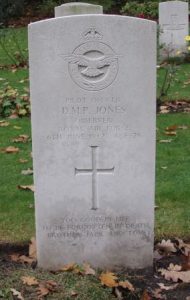
Robert Henry McAlpine, Flight Sergeant, 2221305, Royal Air Force Volunteer Reserve. Robert was born on 19 March 1908, the son of John McAlpine and Margaret Jane McAlpine (nee Irvine), of 13, Oaklands Cottages, Builth Wells. His parents had come to the town from Newtownards, Co Down, and his father ran his own boot store. Robert worked as a bricklayer and mason prior to the war. He enlisted into the Royal Air Force Volunteer Reserve and after training as an Air Gunner was posted to the Operational and Refresher Training Unit at RAF Matching, in Essex. On 29 March 1945, Robert was flying aboard a Short Stirling V, Serial PW391 on a cross-country exercise when the Stirling collided with a Miles Master training aircraft in mid-air and crashed at Knarr Cross Farm, Thorney Toll, Peterborough with the loss of all seven of her crew. Robert was 37 years old when he died during the tragic accident that day and is buried in Eastfield Cemetery, Peterborough, Northamptonshire.
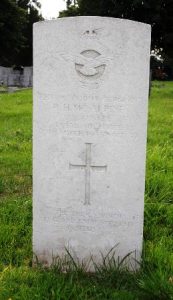
John Leslie Newell, Sergeant, 536881, Royal Air Force. John was born in 1916, the son of Police Constable George Newell and Winifred Newell (nee Evans), of Bryndolau, Park Road, Builth Wells. John enlisted into the Royal Air Force in 1936 and was posted to the Fleet Air Arm, for service aboard aircraft carriers. John served in the Norwegian Campaign of 1940, before being transferring to the aircraft carrier HMS Ark Royal, surviving her sinking on 13 November 1941. He was then posted aboard the aircraft carrier HMS Audacity. She was an escort carrier, which had been built on the hull of the captured German passenger liner MV Hannover. Audacity had no hangar or lift, so her aircraft, eight Grumman Martlet’s, were stowed on her deck, and she was equipped with three arrester cables for landing. On 21 December 1941 Audacity was escorting Convoy HG76 and was some 470 nautical miles off Cape Finisterre, when she was torpedoed and sunk by the German submarine U-751. John was 25 years old when he died during the sinking of Audacity that day. He has no known grave and is commemorated on the Runnymede Memorial, Surrey.
David John Owen, Private, 13062759, Royal Pioneer Corps. David was born on 27 September 1917, the son of Elizabeth Owen, of 3, Pensarn, Llanfrothen, Garreg, Penrhyndeudraeth. He worked as a Process Worker at Cooke’s Explosives Factory prior to the war. David then served during the war with the army. In 1944 he married Jane Annie May Thomas, a Cinema Conductor at Builth and the couple set up home at 12, Castle Road, Builth Wells. David continued to serve in the army after the war, being posted to 519 Company, Royal Pioneer Corps at RAF Long Marston. John died whilst serving at PoW Camp 6 at Long Marston on 6 August 1949. The remains of the 31-year-old were brought home to Builth, and he was buried in Builth Wells Cemetery five days later. David is not commemorated on the Builth Wells war memorial.
Ivor Llewelyn William Powell, Signalman, 2335451, Royal Corps of Signals. Ivor was born at Llanelli, Carmarthenshire in 1919, the son of William Alfred Powell and Sophia Sarah Powell (nee Davies). The family had moved to Bryncoed, Builth Wells prior to the war, after Ivor’s father had gained a position as Forestry and Estate foreman. Ivor left home prior to the war and worked for the Royal Mail at Cambridge. He enlisted into the army following the outbreak of war and was posted to the Royal Corps of Signals, before being drafted to India to join the 5th Division Signals, Indian Signal Corps. Ivor died in India on 3 September 1944. The 25-year-old is buried in Imphal War Cemetery, India.
Jeffreys Price, Gunner, 839426, Royal Artillery. Jeffreys was born in 1918, the son of Thomas Price and Maria Price (nee Harris), of Pear Tree Cottage, Bank Square, Builth Wells. He married Lilian May Jones at Wolverhampton in 1941 and Lilian set up home at 3, Tanhouse Terrace, Builth Wells. Jeffreys was by then already serving with the Royal Artillery and he embarked for the Far East soon after his wedding, attached to the 3rd Battery, 6th Heavy Anti-Aircraft Regiment, Royal Artillery. His battery took up positions at the Singapore garrison, whilst the other two batteries went to Sumatra. On 8 December 1941 the Japanese launched a series of simultaneous attacks against Pearl Harbour, Malaya, Thailand and the Pacific Islands. The Japanese had a force of some 30,000 troops involved in the Malayan invasion but soon reached the outer defences of Singapore following a short period of intense fighting. General Percival, commanding a garrison of some 85,000 troops in Singapore was ordered by Winston Churchill to fight to the last man, however, on 15 February 1942 he surrendered, and 80,000 troops were marched into captivity. Jeffreys was taken into captivity that day, together with the survivors of 3 Battery, and incarcerated at Changi Jail. Jeffreys was later sent to Thailand and put to work with countless other PoW’s on the infamous Thai-Burma Railway. He survived just over three years in captivity but sadly took ill and died of malaria on 29 May 1945. The 27-year-old was buried in Takiri Cemetery. In April 1946 the war graves in the cemetery were exhumed and re-interred in Kanchanaburi War Cemetery, Thailand.
William Thomas Rea, Third Officer, Merchant Navy. William was born in 1922, the son of William Herbert Rea, a Master Mariner, and Amelia Maud Rea (nee Price), of The Greyhound Hotel, Builth Wells. William followed in his fathers’ footsteps and went to sea, joining the Merchant Navy. Soon after the outbreak of war he was posted aboard the steamship SS Fort Mumford. On 20 March 1943, Fort Mumford was steaming in the Indian Ocean, some 500 miles northwest of Ceylon, with a cargo of war supplies for the Mediterranean, having left Vancouver, Canada via Lyttleton, New Zealand and Colombo, when she was torpedoed and sank by the Japanese submarine I-27. Her crew abandoned ship, but the Japanese submarine surfaced and murdered the survivors by machine-gun fire, leaving only one man alive to tell the tale. William was 21 years old when he was killed that day and is commemorated on the Tower Hill Memorial, London.
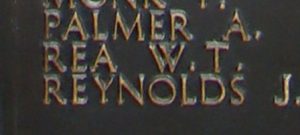
Harold David Taylor, Able Seaman, P/SD/X 1485, Royal Naval Volunteer Reserve. Harold was born at Nesbitt, Manitoba, Canada on 17 May 1913, the son of William Henry Taylor and Sarah Euphemia Taylor (nee Godwin). The family moved back from Canada to Builth Wells at some time after this, and by 1939 Harold was serving in the Royal Navy and lodging at Hazelgrove, Worthing. By the time war erupted he was serving aboard the E-class destroyer HMS Esk. She had been converted to a minelayer when World War II began in September 1939 and spent most of her time laying mines. During the Norwegian Campaign Esk laid mines in Norwegian territorial waters before the Germans invaded but was recalled to home waters to resume her minelaying duties. On 31 August 1940 Esk was laying mines north of Texel, on the Dutch coast, together with Intrepid, Icarus, Ivanhoe and Express when Express struck a German laid mine and lost her bow. Esk steamed in to her aid, but hit a mine herself, exploded and sank with the loss of some 127 lives. Harold was 27 years old when he was killed that day. His body was later recovered from the sea, and he was buried in Pellworm Klostermitteldeich Churchyard, on the Frisian Islands in Germany. In September 1946 the Allied war graves within the cemetery were exhumed and re-interred in Hamburg Cemetery, Germany.
Ronald Vincent Turner, Pilot Officer, 149548, Royal Air Force Volunteer Reserve. Ronald was born on 6 June 1920, the son of George Stanley Turner and Lizzie Mary Turner (nee Brittain), of 3, Oaklands, Builth Wells. He enlisted into the Royal Air Force Volunteer Reserve soon after the outbreak of war and after completing his training as a pilot was commissioned as Pilot Officer on 8 July 1943 and posted to 467 (Royal Australian Air Force) Squadron, Royal Air Force, which was based at RAF Bottesford. Ronald had married Elizabeth Eleanor Morgan at Windsor in the spring of 1943. On the night of 3 September 1943, Ronald took off from Bottesford flying an Avro Lancaster III, Serial DV237 which joined a large bomber force despatched to hit Berlin. Nothing was heard from the aircraft after take-off, and it was later discovered to have crashed near Doberitz in Germany on the morning of 4 September 1943, with the loss of all seven of her crew. Ronald was 23 years old when he was killed that morning. The remains of the crewmen were recovered by the German authorities and were buried in Doberitz Churchyard. In October 1946 their graves were exhumed, and the men were buried together in Berlin 1939-1945 War Cemetery, Germany.
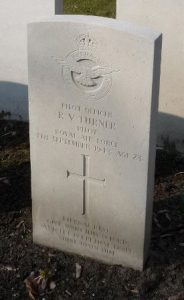
Robert James Wall, Fourth Engineer Officer, Merchant Navy. Robert was born on 30 May 1905, the son of Robert Curtis Wall and Harriet Wall (nee Norman), of 15, Earle Place, Canton, Cardiff. He worked as a motor mechanic at Builth Wells prior to the war. Robert married Annie Ivy Pugh at Builth on 18 January 1930 and the couple set up home at Belmont House, Builth Wells. Robert enlisted into the Merchant Navy soon after the outbreak of war and became Fourth Engineer Officer aboard the London registered cargo steamer SS Bibury. On 23 August 1940, Bibury left Cardiff with a cargo of almost 7,500 tons of coal, bound for Buenos Aires. The steamer joined Convoy OB-205 at Milford Haven for the hazardous voyage across the Atlantic. During the early hours of 31 August 1940, Bibury was steaming together with two other freighters, dispersed from the convoy, when she was struck by two torpedoes which had been fired from the lurking German submarine U-59 and sank within five minutes with the loss of 39 lives. Robert was 35 years old when he died as a result of the attack. He has no known grave but the sea, so he is commemorated on the Tower Hill Memorial, London.
Leslie Thorpe Watson, Serjeant, 6340354, East Lancashire Regiment. Leslie was born on 30 April 1909, the son of John Ross Watson and Nellie Jane Watson (nee Woodcock), of Finches, West Chiltington, Pulborough, Sussex. He married Mary Edwards in 1934 and the couple settled at Builth Wells. Leslie was a regular soldier and was serving with the 1st Battalion, East Lancashire Regiment at the outbreak of war. The Battalion was attached to the 126th Infantry Brigade, 42nd (East Lancashire) Infantry Division and embarked for France in 1940 to join the BEF, taking up positions on the river Escaut. On 17 May one of the brigades of the division was detached, leaving just two brigades to hold the Escaut defences, so was swiftly overwhelmed, before being forced to withdraw together with the rest of the BEF towards Dunkirk, where the remnants of the 1st East Lancs took up positions along the Canal de Bergues, in the Dunkirk perimeter defences. Leslie was killed in action here on the night of 31 May-1 June 1940, during a gallant stand by the battalion which saw its CO, Captain Harold Marcus Ervine-Andrews gain the award of the Victoria Cross. Leslie was 31 years old when he was killed and is buried in Pihen-Les-Guines War Cemetery, France.
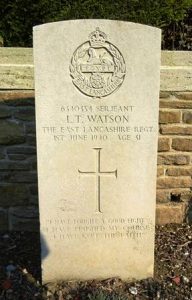
David Willis, Serjeant, 844441, Royal Artillery. David was born in 1918, the son of William Willis and Mary Jane Willis (nee Jones), of Market Street, Builth Wells. He served with 90 Field Regiment, Royal Artillery throughout the war, and married Eileen Mary Sutcliffe whilst based in the Wirral in the summer of 1946. David died at Wallasey on 3 August 1947, aged 29. His remains were brought back home, and he was buried with full military honours in St. Mary’s Churchyard, Builth Wells on 7 August. His uncle, John Thomas Jones, had died in India in 1920 whilst serving with the Indian Army, and his father had served with the Brecknocks throughout the war and had died in 1921. David is not commemorated on the Builth Wells war memorial.
